Season opener
TOP 10 UNDER 40 MEET A NEW CREW OF YOUNG LEADERS
Farmers markets welcome summer's bounty

A NATURAL FIT ROLLS-ROYCE AND PURDUE STRENGTHEN TIES
NO ALCOHOL?
NO PROBLEM! JOIN THE NEWEST TREND


©2023 27538_SDA_BROOK_8.75x11.5_AD_0223 GET A SAME-DAY APPOINTMENT WITH INDIANA’S TOP CARDIOLOGISTS AT INDIANA UNIVERSITY HEALTH. If you have a family history of heart problems, there’s no time to wait. Make a Same-Day appointment with one of our nationally recognized cardiologists. It will give you peace of mind today so you can enjoy many happy tomorrows. Don’t skip a beat. Call 765.448.8100 or visit iuhealth.org/heart
PRIVATELY-OWNED
1-1 SPECIALIZED THERAPY
SPIRITUAL CARE
AtSaint Anthony Rehabilitation & Nursing Center, we believe in delivering the highest quality of client care. Our unparalleled expertise, commitment, and compassion assures that we provide the very best healthcare in each service we offer.
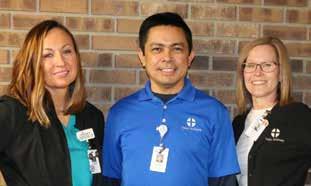
SHORT-TERM CARE
• Physical, occupational & speech therapy, both in/ out patient services
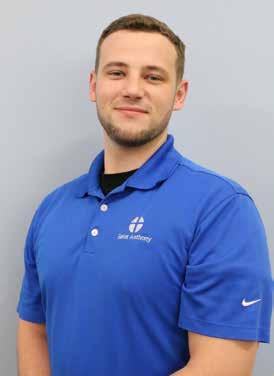
• Cancer Care
• Cardiac Care & Rehab
• Diabetes Care
• IV Therapy
LONG-TERM CARE
• Neuromuscular Rehab
• Stroke Rehab
• Pain Management
• Respiratory Therapy
• Physical, occupational & speech therapy
• Wound Care & Prevention
GREATER LAFAYETTE MAGAZINE 3 To learn more visit SaintAnthonyCares.com or call us at 765.423.4861. 2017 BEST NURSING HOMES U.S.News 2018 BEST NURSING HOMES U.S.News 2019 BEST NURSING HOMES U.S.News 2020 BEST NURSING HOMES U.S.News 2021 BEST NURSING HOMES U.S.News 2022 BEST NURSING HOMES U.S.News
Nicole Hardy, RN, IP, Director of Nursing/Infection Preventionist - 22 years
Garry Gumasing, PT, CWS, SVT-BIG Cert., Director of Therapy - 25 years
Tracie Shoults, RN, Corporate Compliance Officer - 27 years
Dylan Johnson, Administrator - 7 years with Saint Anthony
GREATER LAFAYETTE MAGAZINE
Editor - Carol Bangert
Art Director/Graphic Designer
-
Kara Bishop
Vice President, Marketing & Communications
-
Michelle Brantley
MISSION
Greater Lafayette Magazine captures the spirit and vitality of the people who call Greater Lafayette home and what it means to live, work and thrive here. It tells the region’s success stories, from business expansions, entrepreneurship, leadership and philanthropy to quality of life, arts and cultural events. Our hope is that readers of Greater Lafayette Magazine will become active participants in the world around them and join in our mission to make Greater Lafayette the place where progress, creativity and community come together.
AUDIENCE
Greater Lafayette Magazine serves as the leading quality-of-life and business trade publication for the area. Leveraging our award-winning team of writers and designers, Greater Lafayette Magazine attracts a diverse group of readers who are engaged in the community as consumers, visitors, business leaders, volunteers, residents and future residents of Tippecanoe County. This publication is for anyone that appreciates a good story that not only reveals something new about our community but offers insight and pride for the place we call home.
ADVERTISING
To advertise or receive information about advertising in Greater Lafayette Magazine, contact Amy Sundell at (765) 742-4044 or amy.sundell@greaterlafayettecommerce.com
PRINTER
The National Group
CIRCULATION
Greater Lafayette Magazine is published four times a year (January/April/July/ October), with a print distribution of 4,000, and up to 10,000 online subscribers/views. Distribution channels will include online, mobile, various newsstands, and pass-along venues including restaurants, businesses, organizations, community centers, hotel lobbies and healthcare facilities.
Greater Lafayette Magazine is a publication of Greater Lafayette Commerce
337 Columbia St., Lafayette, IN 47901 (765)742-4044
greaterlafayettecommerce.com
Contact: (765)742-4044
info@greaterlafayettecommerce.com
VOLUME 4, ISSUE 2
Signs of spring popping up around Greater Lafayette
If you’ve lived in Greater Lafayette for any length of time, you know that spring is a season of simple beauty and promise. We’re all shaking off what’s left of winter and looking for signs of spring. Maybe it’s the trees slowly starting to color the woods in green, the first wren hunting for a nesting space, or garden centers with shelves chockful of outdoor plants.
Around here, there’s no greater indicator that warmer weather is upon us than our local farmers markets. The markets ease into the season in May with a small variety of select local produce, baked goods and crafts. Within a month, those same markets are beehives of activity, with everything from fruits and veggies, to locally sourced meats, pet treats, flowers, plants and yard art, live music and meals. Check out what’s planned at the Lafayette, West Lafayette and Purdue farmers markets on Page 42.
Spring is also the time to dust off those golf clubs and hit the links. Greater Lafayette is blessed with a number of challenging golf courses, and those courses are ready, many with new amenities (Page 53).
Local chefs welcome warmer weather with fresh menu options that reflect what is in season – from asparagus to mushrooms to microgreens. Diners looking for a change will not be disappointed with the dishes shared here by four area chefs (Page 66). The best part? You can try these recipes at home.

If cocktails on the deck are part of your warm-weather ritual but you’re looking for a healthier option, Generation NA is worth a look. The nonalcoholic shop on Main Street has enjoyed growing success with its array of NA beers, wines, and spirits. As Generation NA owner Rob Theodorow says, “NA beer has come a long way.” (Page 16)
In this issue we introduce you to 10 young (all under the age of 40) professionals who are making an impact in our community. Each has a passion for what they do professionally, each talks about patience and persistence, and each has a heart for service. I think you’ll be impressed. I know I am (Page 76).
Working in Greater Lafayette has taken on new meaning since the COVID pandemic, and, not surprisingly, our region has been cited as a top spot for remote workers (Page 62). But this is something businesses and manufacturers have long known. Businesses big (Rolls-Royce, Page 10) and those just getting started (Tactile Engineering, Page 22) can attest that Greater Lafayette is part of their strategies for success.
There’s so much going on this time of year, and my hope is that this issue of Greater Lafayette Magazine will get your adventures started.
Happy Spring!
Editor, Greater Lafayette Magazine

SUBSCRIBE TO GLM
Get to know the Greater Lafayette community by subscribing to Greater Lafayette Magazine. It’s easy! Go to greaterlafayettecommerce.com and click on the About Us tab. Then click on Greater Lafayette Magazine to view past issues and subscribe.
WE ARE TOGETHER
4 GREATER LAFAYETTE MAGAZINE
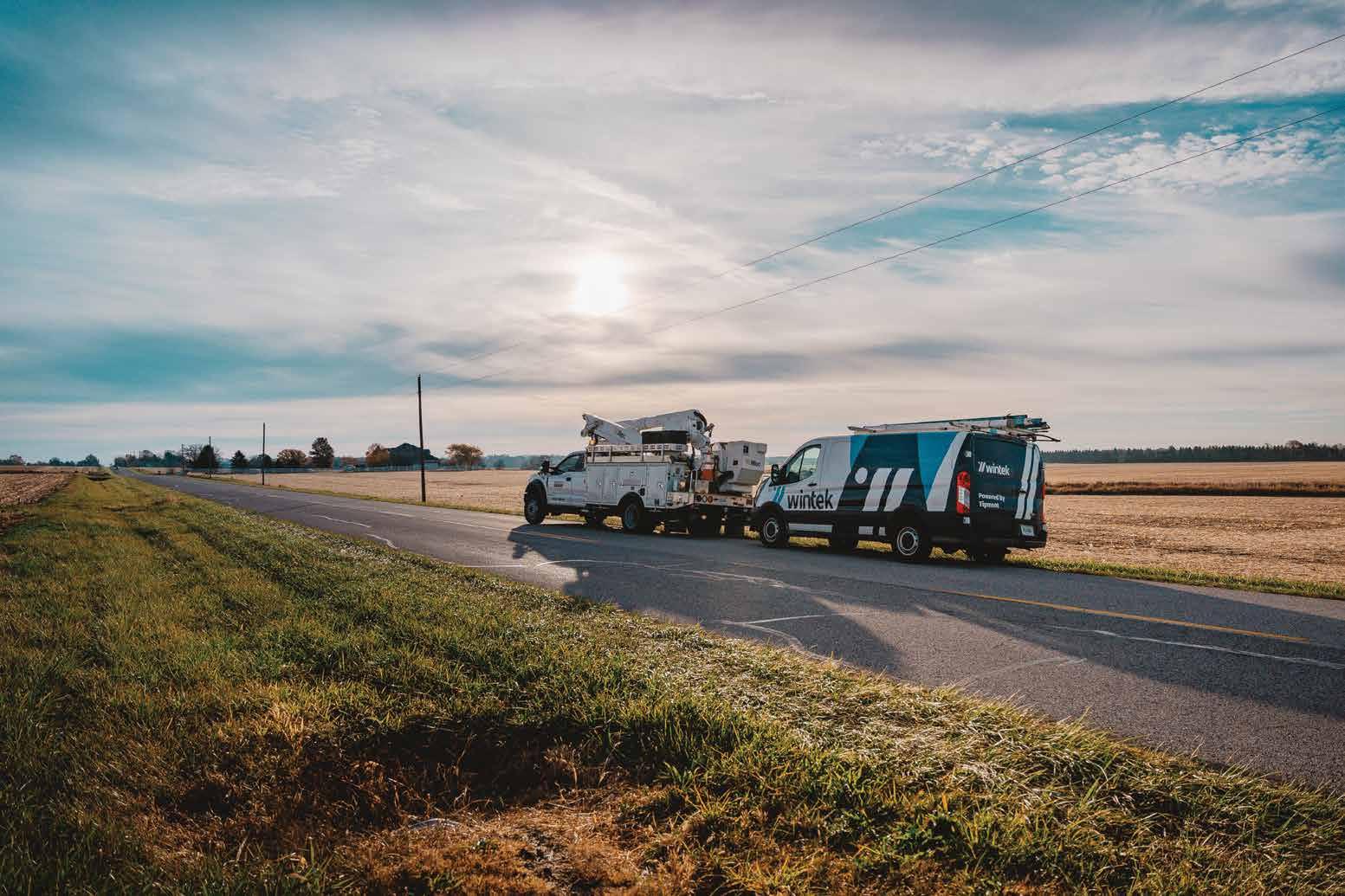
GREATER LAFAYETTE MAGAZINE 5 We make each other better. Learn more about the Tipmont Wintek partnership. WeMakeEachOtherBetter.com You help us thrive as a cooperative. We help you grow as a community.
Welcome Note |page 4
From Editor Carol Bangert
ON THE COVER: Greater Lafayette's farmers markets open for the season in May |page 42

BUSINESS & PROGRESS:
What you got, Scott?
|page 8
Rolls-Royce and Purdue: A $75 million partnership |page 10
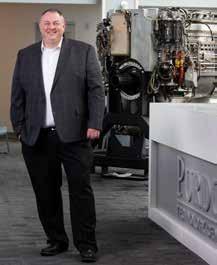
Generation NA serves up non-alcohol options |page 16
Company builds a community for visually impaired |page 22
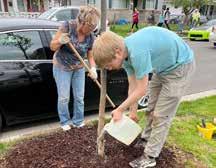
Ask the Experts |page 50
COMMUNITY & CONNECTION:
Tree planting a community effort
page 31
Committee tackles climate challenges |page 36
Tee time at area golf courses
page 53
Greater Lafayette a remote worker haven
page 62
Top 10 Under 40
page 76
FOOD:
Spring recipes from local chefs
page 66

6 GREATER LAFAYETTE MAGAZINE
Photo by Christine Petkov
|
|
|
|
|
42 10 66 31
You
see the potential. We see your future.
You deserve a smart financial partner who knows you. One who’s ready to guide you—and your business— to the next level. One who shares your goals and is focused on your success. We’re Old National. Let’s talk.

YOUR SUCCESS IS EVERYTHING

GREATER LAFAYETTE MAGAZINE 7
140 S Creasy Ln, Lafayette | 100 N 2nd St, Lafayette | 3503 Paramount Dr, West Lafayette | oldnational.com
What you got, Scott?
Thriving community makes room for employment opportunities

According to the Bureau of Labor Statistics (BLS), as of January 2023, the unemployment rate in Greater Lafayette was 2.9%, compared to the United States at 3.9% and Indiana at 3.4%. This low unemployment rate is indicative of the community’s strong and diverse economy, which has been able to weather the economic challenges posed by the COVID-19 pandemic and recovery.
This has not always been the case. In the aftermath of the 2008 financial crisis, Greater Lafayette’s unemployment rate peaked in March 2009 at 10.7%. It took several years for the county’s economy to recover, but since 2011, the unemployment rate has steadily decreased.

The county’s workforce size has also seen fluctuations over the years. As of January 2023, the civilian labor force in Tippecanoe County was 97,591, with 95,165 people employed and 2,426 people unemployed. This represents a slight increase in the labor force from the previous year, when it was 97,024.
The reasons for this increase in the labor force and low unemployment rate are likely two-fold. First, the expansion of the student body at Purdue University has driven the need for more employees — not
8 GREATER LAFAYETTE MAGAZINE
only at Purdue, but also at many of the businesses that serve Purdue and its students. Second, in partnership with Purdue University and the Purdue Research Foundation, the cities and county have been extremely successful in attracting new, high-tech companies and helping the existing advanced manufacturers expand here. Similarly, this drives more demand for restaurants, schools, healthcare, housing, childcare, etc. Our community and region are working to quickly add capacity in those areas as part of the READI Grant and many other initiatives.
Additionally, a quick check of the Indiana Career Connect website, the states job portal, shows more than 4,000 distinct jobs open in Greater Lafayette. All of this is driving people to want to move to Greater Lafayette, and we at Greater Lafayette Commerce are working to help our employers attract the workforce they need. Our workforce attraction website is www.greaterlafayetteind.com. You can find on the website information and resources for people seeking to learn more about Greater Lafayette, articles from Greater Lafayette Magazine, and Community Attraction Videos. Take a look. We encourage you to share the website.

You are all our Brand Ambassadors!
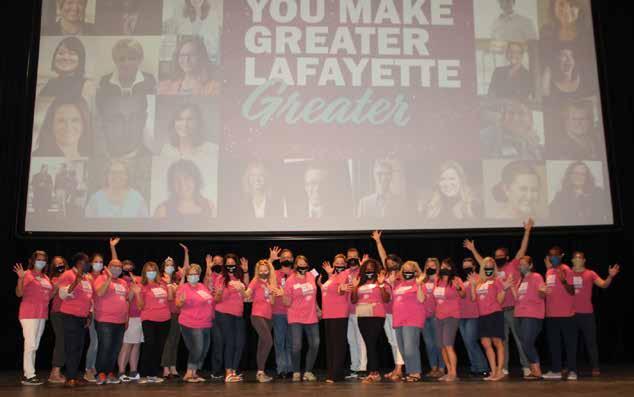
GREATER LAFAYETTE MAGAZINE 9
Scott Walker is the president and CEO of Greater Lafayette Commerce. He can be reached at 765.742.4044
BY KEN THOMPSON PHOTOS BY CHRISTINE PETKOV

WORLD LEADERS
10 GREATER LAFAYETTE MAGAZINE
Warren White, Director of Assembly & Test-U.S. for Rolls-Royce Defense, says, "Indiana is very lucky to have an educational institution like Purdue University as a pillar of research and a true leader in the world of aerospace."
Purdue and Rolls-Royce collaborate for the perfect pairing

he largest deal with an industry partner in Purdue University history is bringing $75 million to West Lafayette over the next 10 years. That the agreement is with Rolls-Royce makes it a natural fit for Purdue, which has had a more than 70-year relationship with the global corporation that has customers in more than 150 countries.

“We have collaborated on many aerospace research projects, worked with numerous Purdue experts and have established a pipeline of talent from the university to our company,” says Warren White, Director of Assembly & TestU.S., Rolls-Royce Defense. “In fact, over 700 Purdue grads work for Rolls-Royce in Indianapolis.
“With the aerospace expertise on campus, the strong support from Lafayette and West Lafayette officials, and the comfort level between the university and the company, it made perfect sense to invest there.”
The agreement funds testing and research in the areas of gas turbine technology and electrical and digital technology. Purdue’s Zucrow Laboratories, the largest academic propulsion laboratory in the world, will be the primary site for research in sustainable power systems through advanced technology in electrification, turbines, compressors and combustion with sustainable fuels.
Just weeks before unveiling the Rolls-Royce deal, Purdue announced it would construct a $73 million high-speed propulsion laboratory for hypersonic technologies in the Discovery Park District. The laboratory will span 55,000 square feet.
At the time the agreement was announced in May 2022, then-Purdue President Mitch Daniels said, “Purdue’s research partnership with Rolls-Royce will address some of
GREATER LAFAYETTE MAGAZINE 11
the greatest technology challenges facing the U.S. Our faculty and students will work on advanced technology capabilities to ensure long-term national security. This will enhance the university’s role as a world leader in engineering research.”
White says, “Indiana is very lucky to have an educational institution like Purdue University as a pillar of research and a true leader in the world of aerospace. Not just the astronauts – although that history is fantastic – but there are so many other areas where Purdue has been in the forefront of technology advancement.
“At Rolls-Royce, we are very proud to be partnering with Purdue and continuing that great history of cutting-edge aerospace development.”
White says Rolls-Royce has a number of projects underway in various stages at West Lafayette, including some of the hybrid-electrical testing work. New facility construction also is taking place, but he says it probably will be a couple of years before Rolls-Royce begins operation of test facilities in other areas.

12 GREATER LAFAYETTE MAGAZINE
Among other research and work at its facility near the Purdue campus, Rolls-Royce manufactures electronic control systems that help gas turbine engines operate at peak efficiency.
Rolls-Royce tests hybrid-electric engine technology at its West Lafayette facility, expanding knowledge that will enable aerospace travel to become more environmentally friendly. The company is investing millions of dollars in its local facilities to expand research in a number of other areas as well, including hypersonic flight and high-altitude test capabilities.
Purdue President Mung Chiang, who began his tenure on Jan. 1, 2023, says, “Purdue has become the epicenter of hypersonic research and testing in the U.S. We are excited across three tracks: first, our own investment for federal and industry projects, such as the wind tunnel and manufacturing facility announced in 2021, and the high-speed propulsion facility in 2022 that Rolls-Royce will be able to use; second, private sector’s investment to grow their presence in the Discovery Park District at Purdue; and third, a nonprofit consortium of industry members for ground testing hosted at Purdue.”
One of those projects is aimed toward the company’s goal to achieve zero net greenhouse gas emissions in its operations by 2030.
“Our hybrid-electrical testing will help move aviation to a more sustainable future by reducing reliance on fossil fuels,” White says.
“High-altitude testing capability will enable us to make our engines more efficient in challenging operating environments. Hypersonic testing will help develop engines

GREATER LAFAYETTE MAGAZINE 13
to help aircraft reach extremely high speeds. All of these are important aerospace ‘giant leaps’ and we are proud to be working with Purdue to advance these efforts.”

White says research and development projects are the primary focus for Rolls-Royce in West Lafayette. Side benefits to these projects are modest job growth in Greater Lafayette as well as enhancing the learning potential of Purdue students and faculty.
The roots of Purdue’s relationship with Rolls-Royce date back to a partnership with a company owned by one of the founders of the Indianapolis Motor Speedway.
James A. Allison founded the Allison Engine Company more than a century ago, and Purdue’s close proximity to Indianapolis led to Allison Engine hiring many Purdue engineering graduates. Rolls-Royce purchased Allison Engine Company in 1996.
“Since that time, hundreds of Purdue engineers have worked for Rolls-Royce, collectively making a major impact on our company’s products and designs,” White says. “The relationship is as strong as ever. We continue to perform research on and off campus and continue to hire Purdue grads every year.”
White, who earned his bachelor’s degree in aero/astro engineering and a master’s degree in industrial administration from Purdue, credits his time in West Lafayette for creating a solid foundation for his professional career.
“We have more Purdue engineers working at RollsRoyce than from any other university,” White says. “My personal background at Purdue didn’t play a role in the company’s decision to invest in West Lafayette, though. All the business factors involved made it the right decision. I’m happy it turned out that way, and I enjoy making trips to campus.”
White has noticed the many changes in Greater Lafayette since his undergraduate and post-graduate days. He praised the unique partnership between Purdue and the cities of Lafayette and West Lafayette.
“We have been happy to witness the economic redevelopment taking place in West Lafayette and Tippecanoe County as a whole,” White says. “The credit goes certainly to mayors, city council members, community leaders and the redevelopment commission — their vision and commitment to the current and future residents of Greater Lafayette.
“This vision along with the investments and growth spurred by the success of Purdue during the Mitch Daniels era and now with President Mung Chiang have been very impressive. Rolls-Royce is proud to be part of the community. It’s a great place to live and work.” ★
14 GREATER LAFAYETTE MAGAZINE
"The relationship is as strong as ever. We continue to perform research on and off campus and continue to hire Purdue grads every year."


GREATER LAFAYETTE MAGAZINE 15
Hybrid-electric engine testing at West Lafayette includes a Rolls-Royce M250 gas turbine engine originally designed for use in military and commercial helicopters. The company has manufactured more than 31,000 helicopter engines at its Indianapolis facilities, employing hundreds of Purdue engineering grads over the years.

"DryJanuary,DryJuly,SoberOctober."
Generation NA supplies Greater Lafayette with eclectic alternatives
 STORY AND PHOTOS BY TIM BROUK
STORY AND PHOTOS BY TIM BROUK
Whether it’s for a rhymable month, years, or just a day, a downtown Lafayette shop is giving former and current beer, wine and liquor drinkers an alternative.
Since its opening last October, Generation NA, 504 Main St., supplies non-alcoholic (NA) beer, seltzers, wines and spirits such as zero-alcohol whiskies, gins and rums to a clientele that likes to balance hard liquor with a non-alcoholic drink or those that have put down the hard stuff for years but miss the hoppy taste of a well-crafted IPA or mixing a classic cocktail. The shop that also features a casual lounge with old-school arcade games has quickly gained momentum, matching national trends in sober drinking.
“Like red meat or processed foods, people are more mindful about what they put in their bodies,” says Rob Theodorow, Generation NA owner, “beverage curator and hype man.”
“I think people will be surprised. I’ve seen a lot of people that can’t quite process it when they first have an NA beer — ‘That tastes like a real beer.’ They almost can’t believe it.”
Generation NA was the first shop of its kind in Indiana when it opened. A few months later, a similar shop was established in Carmel, Theodorow says.
In 2022, Nielsen calculated non-alcoholic beer sales in the United States at $328.6 million, up 19.5% from 2021. Globally, the non-alcoholic market is valued at
$11 billion, up from $8 billion in 2018, according to Forbes.
Theodorow and media outlets point to the COVID-19 pandemic as a possible motivator for stronger sales. The National Institute on Alcohol Abuse and Alcoholism reported sales of alcohol increased in 2020 by 2.9%, the largest annual increase in more than 50 years. Deaths involving alcohol jumped 25.5%, totaling almost 100,000 deaths. Drinkers shifting to non-alcoholic brews is believed to be an after-effect.
Theodorow, also CEO for SFP, a downtown Lafayette web and media production company, noticed a burgeoning market soon after he stopped drinking alcohol two years

18 GREATER LAFAYETTE MAGAZINE
Generation NA owner Rob Theodorow
ago. He invested in several regional breweries and distilleries that provided non-alcoholic products to fuel pop-up sales in his downtown office. Each sale brought in dozens of customers. When the space on Main Street became available, he swooped in, and Generation NA opened in less than a week.



More than O’Douls



Generation NA boasts numerous shelves brimming with cans of non-alcoholic brews. Some recommendations from Theodorow: Athletic Brewing, CERIA and Mash Gang.

The coolers also are stocked with more brews, as well as water and seltzer alternatives. Liquid Death’s canned waters are popular and refreshing. Some products are enhanced by CBD, adaptogens such as lemon balm, kava and ashwagandha, and even “functional mushrooms” such as lion’s mane, reishi and shiitake. These give a relaxing feeling while still staying safe and Indiana legal.

GREATER LAFAYETTE MAGAZINE 19 Hallmark Home Mortgage, LLC NMLS# 53441. This is not a commitment to lend. All loans are subject to credit, underwriting, and property approval guidelines. Terms, conditions and programs subject to change without notice. For further information on Hallmark’s Company and Mortgage Loan Originator’s licensing visit http://www.nmlsconsumeraccess.org/. Hallmark Home Mortgage 7421 Coldwater Rd, Fort Wayne, IN 46825 888.490.1428 03132023 JAIME WILLIAMS BRANCH MANAGER NMLS #826285 219.688.2992 jwilliams@1hallmark.com DAVE MENNEN MORTGAGE LOAN ORIGINATOR NMLS #135837 765.714.8894 dmennen@1hallmark.com MICHELE OVERTON MORTGAGE LOAN ORIGINATOR NMLS #322923 765.776.2119 moverton@1hallmark.com MOVING FOWARD H HALLMARK HOME MORTGAGE Hallmark has the experience, flexibility and mortgage loan options to make buying a home simple. We’re here to help you move forward!
Shelves at Generation NA are filled with colorful - and tasty - options.
“These can help you unwind but also have health benefits like lowering blood sugar and pressure,” says Theodorow, adding that while his shop is all-ages, customers must be 21 or older to purchase anything.
Most big-name breweries have dipped a toe or two into non-alcoholic products. Pabst Blue Ribbon, Budweiser Zero and Coors Edge were all recently launched. Theodorow says Stella Artois’ take tastes the most like the original product. However, there are hundreds of craft brewers who are creating beers most could not tell the difference at first sip.
Theodorow smiled when he revealed his bold entry in the annual Wines on the Wabash event. Of course, he brought all non-alcoholic vintages — some of which fooled even the most sophisticated of palates.
“They had to look at the bottle because they didn’t believe me that it was alcohol-free,” Theodorow says.
‘Very, very close’
Federal law states a non-alcoholic beer is allowed to have up to .5% alcohol. This is due to some alcohol being essential for the product tasting like beer as opposed to hoppy water. Some brews go down to .3% and others go absolute zero, but regardless, that splash of alcohol goes a long way in the flavor department.
“NA beer has come a long way,” Theodorow says. “The mouthfeel and body is on the lighter side sometimes, but we’re 95 to 99% there when people can’t tell between a .3% beer and an 8% beer. We’re very, very close.
“It’s all about the ritual. You come home from work; you have a beer — whether that beer has .5% or 5% (alcohol content), it’s irrelevant. They
just want that beer and flavor.”
Zero-alcohol liquors are a bit different. These contain, yes, zero alcohol but still have a bite and burn that hard liquors contain. However, most no-alcohol whiskeys are yet to taste like traditional whiskey. But, Theodorow says most of his customers that do purchase such bottles use them as mixers. Concocting a Manhattan or an old-fashioned with zero-alcohol whiskeys produces a better drink than just straight neat.
“If that technology improves to where someday you can drink a glass of non-alcoholic bourbon or whiskey side-by-side with a Maker’s Mark or Jack Daniels or any of the bourbons or whiskeys that are out there, that’s when I think even more people will be on board,” Theodorow says.
NA on tap
In January, Generation NA became one of the first shops in the United States to feature a tap system, Theodorow says. The keg came from Lafayette’s own People’s Brewing Company. The local brewery had been eyeing the non-alcoholic beer rise, too. People’s owner Chris Johnson started developing a .5% American pale ale (APA) in 2022 after attending one of Theodorow’s pop-up sales.
“It kept popping up in our trade magazines as something that was coming — NA in general. This is something we should keep the finger on the pulse. We might want to give this a try,” Johnson recalls. “I’ve been brewing commercially for 22 years, and I’ve never done anything like this — trying to make a beer that didn’t have alcohol. We learned a lot, but ultimately we were happy in how it turned out.”
It was only natural for Johnson to
work with Theodorow to get the new beer into the public’s hands. Since the brew is on-draft at the People’s tasting room, a keg and tap system was installed. Now customers can enjoy a pint while shopping, or they can take home a growler.
“It’s really light-bodied. In order to not get a lot of alcohol, we had to use a small amount of malt, which also gives you the body. We used cascade hops, a very traditional pale ale hop. It’s going to be hoppy but not like an IPA,” Johnson explains.
Johnson is thrilled to work with another local business. His brews for Nine Irish Brothers (Nine Irish Red Ale), Purdue University (Boiler Gold and Boiler Black) and St. Boniface (St. Boniface GermanFest) are all among the brewery’s top sellers.
“We’re going to keep doing the NA moving forward. We’ve had a great response so far. It’s definitely been positive. People are really excited that we are getting into it and working on it to begin with,” Johnson says. “Ultimately, we’d like to get it into a package to be able to get it out to (Generation NA) and other stores, bars, restaurants and whatnot.”
Return customers
A couple recent visits saw steady customer flow and Theodorow behind the People’s tap pouring several samples and pints. Remember, Greater Lafayette’s blue collar and collegiate crowds have spilled more beer than most other cities of similar size can drink. Still, Generation NA is cutting through like Pedialyte to a hangover.
Ryan Pritchett sipped on a pint of People’s non-alcoholic APA while shopping for a six-pack and a growler to go. The Rossville man says he quit drinking alcohol eight years ago, but he still missed sipping on
20 GREATER LAFAYETTE MAGAZINE
craft brews, especially from People’s.
“I’ve always liked the taste of beer, but I always thought the only option was O’Doul’s,” Pritchett says. “The variety here is unparalleled, probably better than anywhere in the country.”

Lafayette’s Joel Calabrese and Morgan Welker also had non-alcoholic beer and a six-pack of canned zero-alcohol gin and tonic drinks. The young couple enjoy mock cocktails at home while they cut back on alcohol consumption for 2023.
“We like beer, and we don’t really like pop so (non-alcoholic) beer fills that niche when you want something bubbly while cutting alcohol out,” Calabrese says. “We’re huge fans of this place.”

Welker concurs. “There are so many options, tons of different stuff to try. Compared to beer, you can’t really tell.”
Theodorow says his shop attracts out of town customers, most of whom are passing through Lafayette via I-65 or they drove from out of state specifically for Generation NA. Chicago, Cincinnati, and even California are the most common addresses he sees on visitors’ identification. Most are in the area on travel or vacation and find Generation NA online.
“I really wanted to make this a destination place for Lafayette,” Theodorow says. “I want people to come here as a destination. I want this to be something that can’t be replicated.” ★
GREATER LAFAYETTE MAGAZINE 21
free tastings every Friday.
Enjoy
more about Generation NA at na.beer online.
People's Brewing Company's non-alcoholic APA is on tap at Generation NA.
Learn
BY CINDY GERLACH PHOTOS PROVIDED BY CITY OF LAFAYETTE
25 years in the
making
Local company’s tablet builds community for the visually impaired

22 GREATER LAFAYETTE MAGAZINE
Imagine a tablet computer that can display a map. Or play a video game. Or show a baseball game. Easy enough.
Now imagine a tablet computer that does those things, only in Braille.
This is the dream the team at Tactile Engineering is bringing to reality. The Cadence Tablet, a modular, hand-held device, will bring both static and dynamic content to life in Braille, in order to help the visually impaired experience all facets of life just as their sighted peers do.

The idea came to Wunji Lau, chief marketing officer, and Dave Schleppenbach, CEO, when they were students at Purdue University in the mid-1990s. Schleppenbach had some experience with Braille and was asked to help some visually impaired chemistry students with classes. He and Lau teamed up to assist them.
“We had these two students,” Lau recalls. “They were in pre-med and they were in trouble because chemistry, complex mathematics, any science class, requires a huge amount of graphics. So we were just printing graphics on paper, which was tedious and time-consuming. We thought it would be great if we could just do this electronically, just have the dots move up and down. How hard could that be?
“Well, 25 years later, it’s really hard.”
At the time, Lau and Schleppenbach had to rely on existing technology. Those older versions could only offer static content; plastic diagrams with metal plates were created to make large prints, which were expensive, and bulky — they are tactile, but not easily transportable. This, Lau says, was something they wanted to change; their goal was to create this same content electronically.
“All we want is to do this but in an electronic format,” he says. “Our technology does this, but it allows animation to be shown. Even something simple like just a moving ball. Once we realized we could do that, we have blind kids playing Pong. Furthermore, we have blind kids playing Pong with each other across the table or in separate rooms, on the internet. Internet gaming, internet interaction that blind people never had access to is now open.”
GREATER LAFAYETTE MAGAZINE 23
This is not necessarily new technology, Lau says. There are older versions of Braille tablets that offer this experience. But the old technology used a fragile kind of Braille cell that could only be arranged in a single line of Braille. In order to add another line, the machine just gets thicker and thicker.
“There have been plenty of other projects to make tactile Braille,” says Lau. “But the specific technology to do it affordably and mass produce it is something we have managed to do.”
The primary goal for the Cadence is education, Lau says. They wanted to open up options for courses — higher level science and mathematics — and make them more accessible.

“We always wanted to make it so that anyone who wanted to take a science class, who wanted to go to college, who wanted to find a career that they wanted to do would have that opportunity.”
Education was challenging, in part because of the difficulty in getting textbooks. They are not routinely translated into Braille, so they have to be special ordered. If students wanted to take any kind of science course, they would have to wait for a Braille textbook to be made; the class would start in January and the textbook might show up in April. And then when a student is done with the textbook, there is no resale market. The cost to convert a Braille textbook and have it printed is about $50,000.
The Cadence Tactile Graphics tablet is groundbreaking, too, because it’s modular. One unit is the size of an iPhone, but it’s possible to group four of them together to make a larger screen.
Using translation software, designed by the company, books can be uploaded to the Cadence, including pictures and diagrams — even moving picture. Users can annotate these files — and they can be shared.

“They can collaborate, they can discuss that with their teachers,” Lau says. “Teachers can make new content and distribute it around to all those who need it.
“And that’s really what we wanted to do. We wanted to build this community — a community that sighted people take for granted. This is something that is critical for school, for being able to work. This is what we wanted to do, to give that access.”
This display can cause rivers to highlight; chasing dots can show the flow of different bodies of water or weather patterns. Labels can pop up, in Braille, labels that can change dynamically. Users can zoom in. One of the first pieces of curriculum is an interactive periodic table. Having it all on the Cadence means students do not have to deal with a giant chart, nor do they need 118 individual flashcards.
It opens up, too, leisure activities that blind people have always been locked away from, says Lau. Video games, live sporting events, streaming content.
“This becomes a platform for media and communications and entertainment that has never existed before,” he says. “I’m not
24 GREATER LAFAYETTE MAGAZINE
"We wanted to build this community — a community that sighted people take for granted."
exaggerating when I say it’s a whole new method of communication.”
The tablet is manufactured locally, at Tactile Engineering’s factory on Duncan Road. The start-up company includes Lau and Schleppenbach, along with fellow Purdue grads Alex Moon and Tom Baker.

Also involved? Those two blind students who were tutored by Schleppenbach and Lau back in the '90s.
“Really what drove this were a couple of students who went on to get Ph.D.s in chemistry, believe it or not, as blind students, and they still work with us to this day,” Schleppenbach says. “Kind of far out when you think about it.”
The start-up has support from the Purdue Foundry and other seed money from a group of investors. It also is working with Purdue Manufacturing Extension Partnership, helping it ramp up production from a start-up to a real company.

The factory is as automated as possible, Lau says. They have had help from other Indiana companies — it is a totally Hoosier product, he says. “A lot of the manufacturing techniques we use are things that people said could not be done. So we spent many years proving that wrong.”
There are 384 individual Braille dots in each tablet; each dot is powered to go up and down. Each one has to be carefully wound on a machine. After each coil is made, a set of robots puts them in individual modules; these modules can be replaced separately. Thus, if one part of the display breaks, only that part needs to be replaced; the other three still work.
The parts have to be extremely precise in size; any slight mistake turns into a huge error. Each unit has 64 tiny welds. Initially, all of that was done by hand, but now it’s automated. Everything is carefully tested; each dot is run 25,000 times, to make sure it’s functioning correctly. The displays are then assembled by hand.
The initial deployment centers around schools, starting in Indiana. By May, a dozen or so should be in use at the Indiana School for the Blind and Visually Impaired; the goal is to have 150 to 200 in use by the end of the year. The company is moving slowly because, in addition to manufacturing, tech support needs to be in place. One advantage is that tech support can be done remotely; if a dot gets stuck, it can be pulsed back into alignment remotely.
Ultimately, Lau says they would like to have a Cadence for each student to use and to take home with them. Because continuity is important — they don’t want a break in the learning process.
“We’re trying to minimize the need to ever have to send it back to a repair person,” Lau says. The device can be repaired by any trained electrician.
There is no firm price yet, as the tablet is still in the initial
GREATER LAFAYETTE MAGAZINE 25
“A lot of the manufacturing techniques we use are things that people said could not be done. So we spent many years proving that wrong.”
piloting stage and not yet for sale. But Lau hopes to have it available for $3,000 to $4,000; they want it to be as affordable as possible.
Another advantage to their technology: they use a more common chip, hence no logistics issues.


“It is absolutely about trying to produce the best device that provides the most usefulness and that removes the most barriers between a person and the content they’re trying to get to. That’s really all we want to do,” Lau says.
Lau and Schleppenbach say they never imagined, when they reconnected around 2010, that this problem still existed — they assumed someone had already solved it. When they realized no one had, it became their goal to change the lives of people with visual impairments.
“We have three pillars: hardware, software and the social piece,” Lau says. “We want to make sure it’s getting to the people who need them.” There are thousands of children who are in schools elsewhere, and it has historically proven very difficult to get materials and aid to those children.
“Part of our task and part of advocacy is in finding ways to reach that hidden population of people who need this device,” Schleppenbach says. “The unfortunate reality is a lot of blind people who aren’t in an urban area or don’t have a large amount of resources available to them end up as partial shut-ins, or not
Hearing loss is more prevalent than you might think and can affect communication. Our providers are specially trained to understand, support, and treat hearing loss with cutting-edge technology to keep you and your loved ones hearing clearly.






26 GREATER LAFAYETTE MAGAZINE 823 Park East Blvd, Ste H • Lafayette LafayetteHearingCenter.com 765.588.5554
let hearing loss break your connections. Call today to schedule an appointment!
Don’t
SUPERIOR CARE
SUPERIOR HEARING
Susan Taulia, Au.D., Licensed Audiologist • Joelle Beisel, H.I.S., Hearing Instrument Specialist Andrea Gray, M.S., Licensed Audiologist • Nicole Mielnicki, Au.D., Licensed Audiologist
MEANS
getting adequate education, or end up shuffled off someplace where they don’t have a voice and they can’t get out. And we want to be able to change that.”
Schleppenbach says this concept, which is incredibly intricate and complex, has been one that is rewarding. It’s a project that has been 25 years in the making. But the process of changing people’s hearts and minds is not always quick and easy.
“The scale we work at is so small, so many moving parts, so many different areas of physics, chemistry and math that come together to make this work,” he says. “Yet despite all that, it’s not really about that tech, it’s about the impact on a person. And that’s something that’s hard to measure.”
The CDC estimates that 3 percent of children in grades K-12 are severely visually impaired, says Schleppenbach. These students can’t use a Chromebook to do their homework, they can’t see the blackboard, they may not even be able to find the restroom or might have trouble at recess.

“It’s a very different experience for those kids,” he says. “And nobody talks about it; they don’t have a voice. People don’t know because they don’t have an avenue to express that. So, they wait for people to come help them, and there’s no agency in that. We want them to have that agency given to them because they’ve got the technology to connect with people to be their own voice.”
The visually impaired can feel as if they are second-class citizens, Schleppenbach says. There are so many ways they can’t easily function, everything from taking exams to paying for items with cash to starting a washing machine. These things can all add up, and “it’s like a weight you carry,” he says. Yet there is a place for them in society; there are careers open to them and employers who would embrace them. This tablet can help with that.
“I feel that as a society it’s inherent in our culture, especially in America where we celebrate diversity, the great melting pot, we have an obligation to raise each other up,” he says.
“If we don’t pursue that to the best of our ability, not only is that wrong, but we’re missing so much. Do you really want to have 3% of your society not able to participate? They could be workers, they could be teachers, they could be the next genius. Who’s the next Stephen Hawking? Nowadays people are really sensitive to diversity and equity. Some issues of equity are not solvable with technology, but this one is.” ★
GREATER LAFAYETTE MAGAZINE 27
“I feel that as a society it’s inherent in our culture, especially in America where we celebrate diversity, the great melting pot, we have an obligation to raise each other up.”
"People are really sensitive to diversity and equity. Some issues of equity are not solvable with technology, but this one is.”
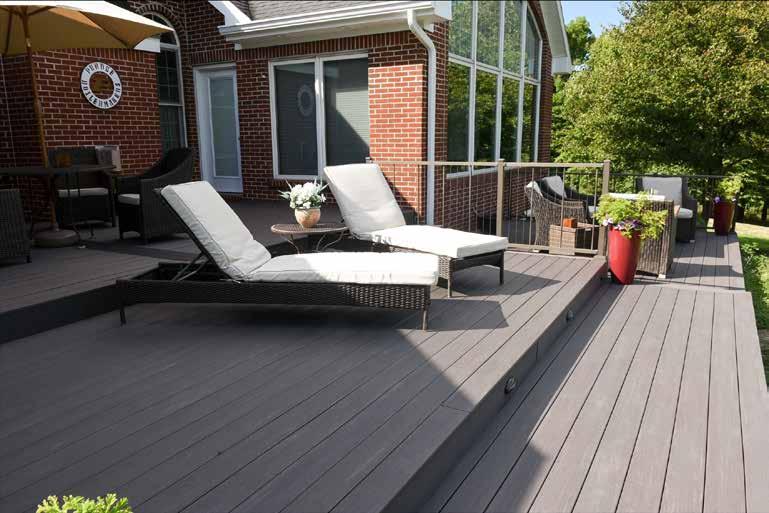






28 GREATER LAFAYETTE MAGAZINE We are a diverse remodeling company with custom design services, providing an unrivaled 10-year workmanship warranty for your peace of mind! Kitchens/Baths • Living Space & Additions • Decks • Roofing • Siding • Windows & Doors 765.449.2600 CoorsRemodeling.com est. 1993 RENDER REAL 765-767-4700 • HeavenlyDecks.com • ACompany INTERIORSEXTERIORSADDITIONS
In 2021, Purdue University recruited Dr. Jerome Adams, the 20th Surgeon General of the United States, as the university’s first ever Director of Health Equity initiatives (HEI). Dr. Adams was hired to leverage Purdue’s many unique assets to ensure more communities have opportunities to make healthy choices and live healthy lives. Based on guidance from faculty members, three thematic areas of focus were identified in early 2022: Food for Health, Infectious Diseases, and Mental Health and Substance Use. Faculty felt these thematic areas would give us space to learn, grow, engage, and create an impact in the health equity space across Indiana and beyond. Further, Purdue’s strengths in education and research, technology and data, engagement
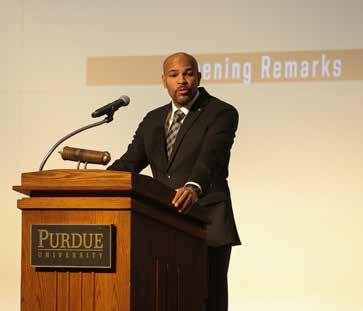
Purdue Engagement to Drive Local Health Equity Impact
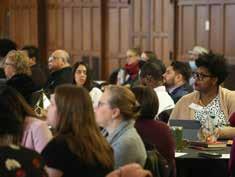
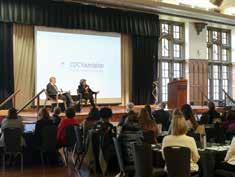
Led by 20th Surgeon General Dr. Jerome Adams
Dr. Adams and his team are working aggressively to engage faculty, students, and staff across Purdue’s ecosystem to maximize the University’s impact in the Health Equity space both internally and with external partners. The end goal is to help fulfill Purdue’s land grant mission by promoting community health and success through ongoing partnerships and engagement. As an example of this work, the HEI Office recently released a seed funding opportunity to Kathleen Abrahamson, associate professor of nursing from the College of Health and Human Sciences. Her project is exploring the mental health challenges that exist within a local nursing facility.
Abrahamson anticipates that two evidenced-based reports will be provided to the facility in May 2023 and September 2023 regarding the current mental health climate of the facility and that the data collected through this seed funding opportunity will be utilized to apply for additional funding to design an expanded project to address the quality of life and mental health and well-being among nursing home residents.
and entrepreneurship, and communication and policy provide a strong foundation for making a difference in these initially identified areas of opportunity.
Abrahamson’s project will consist of semi-structured interviews conducted by a nursing doctoral student with staff members and leaders to assess perceptions of facility climate, wellness needs, and ideas for change. Staff members will then be sent a validated survey instrument to provide a baseline measure for staff before intervention design. Lastly, a team of undergraduate students will conduct a faculty-led assessment of potential areas for quality improvement. The Purdue chapter of IHI Open School has committed to assisting the facility in implementing quality projects related to the mental health environment of the facility.
The Purdue HEI team would love to engage with your organization to work on additional projects which can improve health equity in the Lafayette community. To connect with any of our faculty members or learn more about our work, please visit our website: https://www.purdue.edu/ provost/health
- provided by Purdue University Health Equity Initiatives
GREATER LAFAYETTE MAGAZINE 29

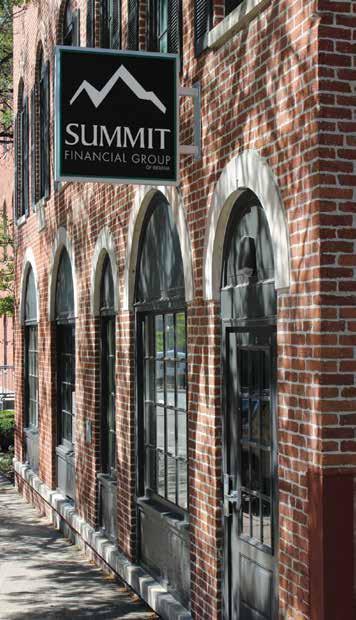







30 GREATER LAFAYETTE MAGAZINE Securities o ered through Regulus Financial Group, LLC. Member FINRA/SIPC. Investment advisory services o ered through Regal Investment Advisors, LLC, an SEC Registered Investment Advisor. Registration with the SEC does not imply any level of skill or training. Regulus Financial Group, LLC and Regal Investment Advisors are a liated entities. Summit Financial Group of Indiana is independent of Regulus Financial Group, LLC and Regal Investment Advisors. We collaborate with clients to: Plan and prepare for retirement Reduce or become debt free Reduce nancial stress and ambiguity Create a business succession plan Prepare to purchase a new home or major remodels Pay for your child’s education Retirement Planning | Financial Planning | Wealth Management Over 20 Years Experience Have the ability to travel and experience more of what you want
Tree City
Lafayette recognized for its efforts to plant and maintain an urban forest.
 BY KAT BRATZ PHOTOS PROVIDED
BY KAT BRATZ PHOTOS PROVIDED
GREATER LAFAYETTE MAGAZINE 31
sk Tim Detzner what he loves about trees, and you can hear the smile in his voice.
“So many things,” says Detzner, who retired as urban forester for the City of Lafayette in January. “I love watching them grow and seeing the different changes that take place. I love all the amazing services they provide for us. They clean carbon dioxide out of the air, provide oxygen for us to breathe, provide shade to lower temperatures, help reduce stormwater runoff and they add beauty to our surroundings.
“There are so many things to love about trees.”
Detzner worked at Purdue University for 34 years as lead arborist before taking the job as a city forester in 2017. He describes the role as a one-person position where

the responsibilities largely include oversight and coordination of the planting and maintenance of street trees throughout the city.
“A city forester has to consider the urban conditions that affect species selection,” Detzner says. “There’s an awful lot of concrete around these trees, so you want to plan trees that will handle the city environment better than others, such as narrow trees that can grow and thrive without interfering with the buildings and sidewalks around them.”
The city frequently collaborates with Tree Lafayette, a nonprofit organization that has planted trees around the city since its founding in 1993.
“Tree Lafayette has planted more than 4,000 trees over the past three decades,” says Larry Rose, tree com-
mittee chair for Tree Lafayette. “We only have one planet to live on and we’d better take care of it. Trees help slow down climate change, produce much of the rain and clean the air. We encourage an urban forest for so many reasons.”
One of the city’s largest tree planting projects took place in 2022 when scores of volunteers helped plant 150 trees in honor of the 150th anniversary of Arbor Day. The trees were planted along Underwood Street in north Lafayette. The first 66 trees were planted in the spring and the remaining 84 were planted in the fall. In recognition of the community’s efforts, the International Society of Arboriculture recognized Lafayette with the Harry J. Banker Gold Leaf Award for outstanding Arbor Day activities.
32 GREATER LAFAYETTE MAGAZINE
“The beautiful thing about trees is that they can be found everywhere. With trees, there’s always an opportunity to keep learning.”
Lafayette has achieved Tree City USA recognition for 30 straight years by meeting the program’s four requirements: forming a tree board or department; creating a tree-care ordinance; designating an annual community forestry budget of at least $2 per capita; and observing Arbor Day with a city proclamation.
In 2022, Lafayette was one of only 138 cities across the globe to earn the designation of Tree Cities of the World. To be recognized, a city must meet core standards that illustrate a commitment to caring for its trees and urban forest on a higher level.
“Lafayette is very proud to receive these tree designation awards after many months and years of work by so many individuals and groups,” stated Mayor Tony Roswarski in an April 2022 press release. “Through
our work with the City’s Urban Forester and other city departments, I’m excited to announce that we have a goal to plant over 1,000 trees in Lafayette over the next five years that will play an integral part in the work of the Greater Lafayette Climate Action Plan. We have a responsibility to combat climate change and I want to thank our partners of Tree Lafayette, SIA, Duke Energy, Center Pointe Energy, Tipmont REMC and the Lafayette Tree Advisory Committee for all their support over the years in making a difference in our community’s environmental footprint. By working together, we can make Lafayette greener.”
The work to plant more trees throughout the city will continue, but it will continue without Detzner.

After 45 years of tree care in Tippecanoe County, Detzner moved to South Carolina earlier this year to enjoy his retirement. ★
Tim’s Tree Tips
The main consideration when selecting a tree is to allow enough room for it to spread and grow. The root system will spread as wide as the crown. His favorite species are white oak and sugar maple.
“They’re large, majestic trees that will live for hundreds of years,” he says. “They have a nice dark green color in the summer and turn red and orange in the fall. They’re just strong, sturdy trees that can handle adverse conditions.”
GREATER LAFAYETTE MAGAZINE 33
Did You Know?
More than 22,000 trees are planted in public spaces across Lafayette, including city parks.
Do You Have a Big Tree?
The Lafayette Parks Department Urban Forestry Division maintains a big tree registry for Tippecanoe County. Only trees native to Indiana are considered for the registry. To enter a tree for submission to the registry, visit lafayette.in.gov/2025/urban-forestry.



34 GREATER LAFAYETTE MAGAZINE



GREATER LAFAYETTE MAGAZINE 35 Friendly People ,Friendly Prices Locally Owned Gas Stations & Convenience Stores VISIT US @ WWW.FRIENDLYMARKET.US FRIENDLYMARKET1 FRIENDLYMARKET765 Volunteer with Tree Lafayette Join a dedicated team of world changers working to improve the community and the environment one tree at a time. For more information, visit treelafayette.org/get-involved.
BY BRADLEY OPPENHEIM PHOTOS PROVIDED
TIME TO TAKE ACTION
Leaders come together to ensure a healthy, sustainable future for Tippecanoe County


n a joint effort, Lafayette, West Lafayette and Tippecanoe County have made it a priority to address climate change and how it’s making an impact here in our own backyards.
After more than two years of gathering scientific data and input from the public, the Greater Lafayette Climate Action Plan maps out both current and projected climate challenges and how we can take action now in creating a more sustainable Greater Lafayette for years to come.
Margy Deverall represents the city of Lafayette as a member of the plan’s Joint Leadership Committee, which was responsible for managing efforts to model the plan. “We are already experiencing change. We see more extreme heat days in summer, flooding events, poor air quality, among other things,” she says. “The plan looks at ways to address those making the community more resilient. We also look at energy costs and changes in where our energy comes from. Planning ahead for those likely changes makes us more sustainable.”
According to Deverall, the city of West Lafayette kicked things off several years ago when it began working with Indiana University’s Environmental Resilience Institute (ERI), which works with partners throughout the state in confronting environmental change through research, education and community collaboration. Soon after West Lafayette began pursuing studies, leaders in Lafayette pondered their own plan, reaching out to leaders on the other side of the river, seeking advice and information about IU’s ERI.
“The first thing we did as members of the IU Environmental Resilience Institute (ERI) Cohort Program, was gather information to determine our current greenhouse gas emissions (amounts and sources),” Deverall says. “Going forward, that can be remeasured, and we can see how we have improved on that number.”
Ultimately, the two cities decided to pool their resources and combine efforts. “The climate doesn’t stop at the river,” Deverall says. “The climate doesn’t stop at the city limits either.” Tippecanoe County also was invited to join in the effort.
Working with a shared vision, the three entities split costs and hired Greeley & Hansen, an environmental engineering firm, to help construct a plan and gather public input.
Once planning meetings were underway, the Joint Leadership Committee worked alongside Greeley & Hansen, interns and fellows from both Purdue and Indiana universities, gathering data. An Advisory Committee also was established, made up of community members and content specialists, tasked with providing input and expertise. In addition to these committees, hundreds of Greater Lafayette residents played a crucial role in providing their input through online focus sessions and in-person meetings.
38 GREATER LAFAYETTE MAGAZINE
"The plan looks at ways maketothe community more resilient."
“We garnered resident feedback and input, and by doing so, the public can look to this plan when holding government accountable and continue to raise awareness about environmental issues,” says Michael Thompson, a Joint Planning Committee member representing Tippecanoe County. “If residents have been seeking an opportunity to get involved, now is the time.”

Fellow Joint Committee Member Lindsey Payne, an assistant professor of practice in environmental and ecological engineering at Purdue University and member of West Lafayette’s Go Greener Commission, shares the same mindset as Thompson. “Climate action is about community health and wellness and creating a better, more sustainable, resilient, and equity future for all,” Payne says.
The framework leading up to implementation of the plan was split into five program phases: initiation, development, execution, report development and implementation.

“Many, many people have been supportive of this effort, and almost everyone has commented that community leaders should be taking action quickly,” says Amy Krzton-Presson, watershed coordinator for the Wabash River Enhancement Corporation and Joint Leadership Committee member. “They want to know that our local government and industry leaders value these initiatives enough to act on them now. Planning is important, but it is time to take action and the public wants to see that action now.”
Following copious amounts of man hours spent planning, advocating and gathering data, the plan was finalized and made available to the public earlier this year. “As individuals, we truly can build the community we want to live in, we just have to make that commitment, act and support each other in our efforts,” Payne says. “It is really about the community coming together to shape this future for themselves and their future generations.”
GREATER LAFAYETTE MAGAZINE 39
"It is really about togethercoming to shapefuturethis for themselves and their future generations."
Mentioned in the plan, a 2017 greenhouse gas inventory divided the county’s emissions into eight categories that were ultimately combined into four focus areas. This includes energy use in the built environment, transportation, agriculture and forestry, and water, wastewater, and solid waste. Each of these focus areas consists of an overview/background and further outlines goals, including actions, cost to implement, co-benefits and an implementation timeline. To keep the burdens of climate change on the low end, the goal is to reduce Greater Lafayette’s greenhouse gas emissions by 58% by 2030 and 80% by 2050.
Statistics also are embedded throughout the plan, putting the effects of climate change in perspective. For example, by the 2050s, it’s projected that the hottest day of the year in Tippecanoe County could soar to 105 degrees, which is 10 degrees warmer than the hottest day of the year during the 1970s to 2000s. On the opposite spectrum, it’s projected that the coldest day of the year will drop to -3 degrees, and while that’s bone-chilling cold, it’s still 10 degrees warmer than the average coldest day of the year between the 1970s and 2000s, which was -13 degrees. While studies were carried out for each of the three communities, the results were presented on a county-wide basis.
“Climbing temperatures aside, the plan helps outline how we as a community can be more resilient and identify those who are at greatest risk — the elderly, young, health impaired, low income, etc.,” Deverall says.
Funding also is addressed, where it’s noted that implementation of many of these projects will save taxpayer dollars in the long run. According to the plan, several community-wide programs can be funded through grants and programs at all levels of government.
In conclusion, a checklist cites specifics in each focus area as to how residents can play a part in reducing greenhouse gas emissions, ranging from keeping your thermostat one degree cooler in the winter to planting trees on your property.
Halee Griffey is a climate resiliency and sustainability officer for the city of West Lafayette. Part of her role includes implementing the plan. She says collaboration plays a crucial role in the equitable, comprehensive implementation of the plan.
“I am feeling very fortunate to have had the opportunity to collaborate with departments, commissions and committees of the city of West Lafayette, government partners from the city of Lafayette and Tippecanoe County, local community organizations, private businesses and engaged residents as well as state leaders in climate action,” says Griffey. “Although the plan has already been adopted, early-stage implementation
If you’re interested in learning more about the Greater Lafayette Climate Action Plan and reading it in its entirety, visit GreaterLafayetteClimate.com
40 GREATER LAFAYETTE MAGAZINE
"Climate planning is an act of hope, preparedness and thinking about the future."
Play?

continues to involve a notable amount of planning. More specifically, not all actions are created the same, and efforts are being made to prioritize and plan for both short-term and long-term goals in terms of partnership development, timeline creation and resource allocation.”


While there is no simplified version of the plan, Deverall encourages everyone to invest the time to read through it thoroughly, “You can skip to the end and read the suggestions under implementation,” she says. “But not going over the data we spent two years gathering is a pretty poor way to acknowledge all the work we did for the community.” If they haven’t already, residents are encouraged to attend scheduled meetings and to sign up to receive email updates. “Both cities and the county have social media accounts and use local media releases to keep the community in the loop,” Deverall says.
Krzton-Presson says taking these actions needs to happen at every level in our community – individuals, industry, schools, government, churches. Everyone should be working to work and live more sustainably. “Climate planning is an act of hope, preparedness and thinking about the future,” says Krzton-Presson. “Those are all things any community should be thinking about if they want to be active and not passive.” ★
GREATER LAFAYETTE MAGAZINE 41
or
We’ve got you covered with three unique community center campuses. Visit us online to check out what we have to offer or stop by to see us. We’ll be happy to show you around! Northend Community Center 2000 Elmwood Ave, Lafayette 765-449-3760 Faith East Community Center 5572 Mercy Way, Lafayette 765-449-3740 Faith West Community Center 1920 Northwestern Ave, West Lafayette 765-449-3750 faithlafayette.org/community
Work
 BY JILLIAN ELLISON PHOTOS ON THIS PAGE
BY CHRISTINE PETKOV
BY JILLIAN ELLISON PHOTOS ON THIS PAGE
BY CHRISTINE PETKOV
SEASON P E N E R



GREATER LAFAYETTE MAGAZINE 43
ew events throughout the year offer signs of better weather ahead than the first farmers markets of the season. Starting the first week of May, farmers markets hosted in downtown Lafayette, in West Lafayette’s Cumberland Park and on Purdue University’s campus will pick back up to a warm welcome.

Brittany Matthews, events director for Greater Lafayette Commerce, says regular goers shouldn’t expect many changes to the Lafayette or Purdue markets, both run by Greater Lafayette Commerce. The 2022 expansion of the historic Lafayette market’s footprint along Fifth Street, growing from the intersections of Columbia and Main streets farther north to Ferry Street, proved to be a great success, with the market nearly at its 40-vendor capacity just two months before kickoff.
“We are always open to new vendors joining the market, provided we have the space,” Matthews says. “We have had some inquiries from potential new vendors, but no specifics have been laid out just yet.”

A few vendors popular among market goers will be returning to the Purdue and downtown markets for 2023, Matthews says, including: RDM Farms, an aquaculture farm operation specializing in shrimp production; Maggie’s Kitchen, a local caterer crafting West African cuisine; and The Vegan Cheese Lady, an artisan dairy-free cheesemaker based in Lafayette.
While Lafayette’s 184-year-old market has experienced growth, the market
44 GREATER
MAGAZINE
LAFAYETTE
Farmers markets shake off the cold and welcome a new season.
PHOTOS PROVIDED BY VISIT LAFAYETTE- WEST LAFAYETTE
Avalon Bluff Phase III
Avalon Bluff is conveniently located on the south side of Lafayette near top-rated county schools and amenities including shopping, restaurants, walking trails and parks.

Homes start at the $230’s Spec Homes now available.
Contact Sales Representative Haley Tarter 765.430.6284
haley@tempesthomes.com

Barrington Lakes Phase II
Barrington Lakes is conveniently located on the east side of Lafayette across from Wyandotte Elementary School. Enjoy beautiful country living conveniently close to I65.
Homes start at the $250’s with ranch and two-story plans now available.
GREATER LAFAYETTE MAGAZINE 45
FOR MORE INFORMATION PLEASE VISIT TEMPESTHOMES.COM
held on Purdue’s Memorial Mall each season is limited in how much bigger it can grow.
“We would love to see the campus market continue to grow, and we are working on some ideas to make that happen,” Matthews says. “The challenge that market faces isn’t necessarily space within the mall’s footprint, but more of parking challenges and electricity options.”
All vendors who participate in the Purdue market are participants in the downtown Lafayette market, Matthews explains, but not the other way around. During the 2022 market season, a wait list was created for vendors interested in getting into the campus market, proving to the planning team the need for some creative thinking in ways to expand its layout.
The Lafayette market, whose presenting partner is Subaru of Indiana Automotive, sees participation from vendors traveling from 10 surrounding counties, making it a true Greater Lafayette event. Despite growing pains, Matthews says the feedback her teams receive from both markets is overwhelmingly positive.


“The markets are a staple to the community and serve as a place where attendees can experience culture and source locally grown and made products,” she says. “The markets are so well received that the McAllister Center in Lafayette hosted a winter market this year to allow market goers to have a winter outlet.”

46 GREATER LAFAYETTE MAGAZINE
Visitors can expect the same hours during this year’s season as well, with Lafayette’s market hosting Saturdays from 8 a.m. to 12:30 p.m., while Purdue hosts on Thursdays from 11 a.m. to 3 p.m., from May to October.
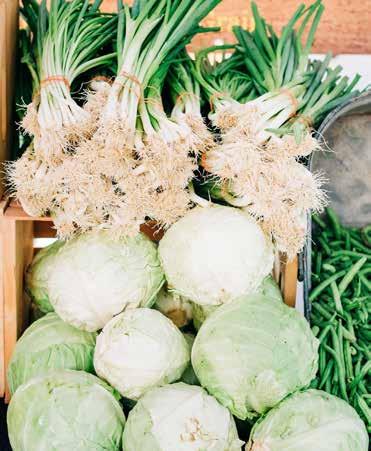
For shoppers looking for a weeknight market fix, the West Lafayette market has your answer. This pet-friendly market offers 60 vendors, says market manager Shelly Foran, with an array of produce, meats, dairy, plants and flowers, along with jewelry, baked goods, crafts and wine by the glass; area restaurants and food trucks serve up take-out options. The market, located at Cumberland Park, runs 3:30-7 p.m. each Wednesday from
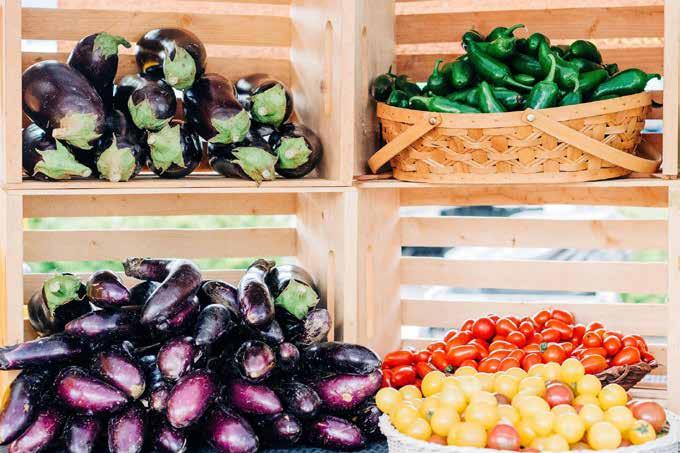
GREATER LAFAYETTE MAGAZINE 47

May through October.
Matthews says no plans are in place to expand the Lafayette market’s hours further into the afternoon, as wrapping up by 12:30 p.m. ensures the city is able to host other downtown events and festivals that require Saturday setup.

“Our vendors work hard to grow and expand their offerings to keep things fresh and engaging for market attendees,” Matthews says. “We are always hoping to continue to grow the market with new vendors and new ideas, which make the experience better for both attendees as well as our regular vendors.”
After a long winter spent inside, Matthews says few things help shake off the feeling of cold weather for her than the opportunity to walk around Greater Lafayette’s busiest hubs and interact with her community face to face.
“I love the open air feel the markets offer,” she says. “It is so much fun to walk the footprint, listening to music, sourcing fresh flowers and veggies along with unique homemade items. We are really looking forward to two great market seasons.”
Foran agrees, adding the West Lafayette market has a number of new attractions this year. “We’re very excited about the coming season.” ★

GREATER LAFAYETTE MAGAZINE 49
Ask The Experts:
Do you have questions regarding business challenges you are facing?
The Greater Lafayette Commerce Ask the Experts program is perfect for you. Greater Lafayette Commerce is teaming with experienced professionals who have the skills you’re looking for to help you overcome challenges and provide you with perspective and direction.
Ask the Experts provides small business owners with the information they need while also facilitating the development of lasting professional relationships.
Floyd Keith
Floyd Keith has served as the Director for Racial and Social Justice for YWCA Greater Lafayette since 2021.This position is sponsored by a collaborative by the Indiana Department of Health and City of Lafayette.
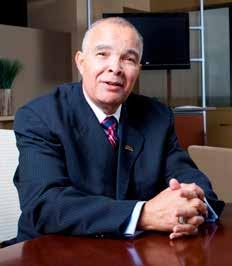
The YWCA Racial and Social Justice program currently provides a Diversity Education Program consisting of 12 workshops and access to the renowned Intercultural Development Inventory Assessment Program, which is under the leadership of Keith.
Additionally, Keith is the chairperson for the 11 person Community Action Team created by the recent passage of the three resolutions of local city councils declaring racism as a public health crisis in 2021. This group is addressing concerns regarding health, education, criminal justice, environment, housing, economy and employment.
Keith has more than five decades of professional experience in education, diversity and inclusion, and social justice advocacy.
QUESTION: How do you identify and hire diverse candidates for your open positions?
Embracing diversity and inclusion in the workplace has beneficial outcomes, such as improving productivity and enhancing the ability to maneuver in an increasingly complex and diverse environment. Additionally, inclusion provides an organization with diverse and varied capabilities and skills that allow companies to reach their full potential as it relates to a shared mission, vision or goals.
In December 2012, the U.S. Census bureau projected that in 2043 the U.S. would become a majority-minority nation for the first time. The non-Hispanic white population will be the largest single group, and no group will make up a majority. The minority population is projected to increase from 37% of the U.S. population to 57% by 2060. Additionally, our total population will more than double, from 116.2 million to 241.3 million between now and 2060.
Diversity is the condition of being different or having differences. These differences can include age, ethnicity, gender, health, physical and mental ability, race, sexual orientation, religion, physical size, educational level, job and function, personality traits and other human differences.
Inclusion is engaging in behaviors and practices that seek out, invite, welcome, allow, engage, involve or in other ways include the participation of others in information sharing, events, dialogue, input, creative initiatives, support, problem solving, decision making and sharing of resources and control.
Research tells us that diversity and inclusion are good business for the following reasons:
• Increase staff retention and productivity
• Enhance responsiveness to an increasingly diverse world of customers
• Increase the organization’s ability to cope with ongoing change
• Improve relations with the surrounding communities
• Expand the creativity of the organization
50 GREATER
LAFAYETTE MAGAZINE
Throughout my nearly two decades of working to improve and enhance equitable hiring, a common statement heard from employers was, “If I had known ‘one,’ I certainly would have considered them.” Unfortunately, this statement was valid to the hiring source because their resources for candidates was limited to the usual job sites and internet options.
My experience regarding hiring practices has taught me two important facts: Established relationships are valuable in the recommendation of potential candidates; and being comfortable with the hired candidate is paramount. While relationships and comfort levels have multiple layers of determinants, I developed a hiring process that works effectively for employers.
Expanding resources for diverse candidates is part of the solution to the lack of candidates available. While this article does not permit the acknowledgment of every possible link for candidates, the following is a synopsis of the diverse candidate sources:
• Job sites such as LinkedIn and Indeed
• Local human relations commissions
• Multiple Lafayette diversity resources
• Greater Lafayette Immigrant Allies
• Greater Lafayette Indiana Black Expo
• Indian Women’s Association
• International Center
• Latino Center for Wellness and Education
• Regional resources, such as Indiana Executive Network and DRT of Central Indiana
• National resources, such as the National Pan-Hellenic Council, American Association of Blacks in Higher Education and Black Sports Professionals
• Personal contacts of influence through first-level relationships
The five essential elements of the hiring process serve as the guidelines for achieving the goal of increasing diversity and inclusion within an organization. It is about the process first, then the hire. Following the framework of these core principles will produce desired results if implemented and adhered to. They are:
• The number of direct communications with a diversity resource regarding candidates
• The number of diverse people on the search committee/total people on the committee
• The number of diverse candidates provided an official interview/total number of official interviews
• A reasonable timeframe for the search and hiring process to conclude
• Adherence to human resource hiring policies
The results of the hiring process are a matter of record in the landscape of collegiate athletics. The world of sports is a microcosm of business, and the shortcomings of attempting to hire diverse candidates in sports are reflected in the hiring processes of business in our society.
For example, the equitable hiring process promoted and utilized by collegiate athletic programs on the Football Bowl Subdivision (FBS) level from 2004-2012 produced the following results:
• 61% of all the minority football coaches ever hired on the FBS level were hired in the 9 years of the Black Coaches and Administrators (BCA) football hiring process initiated in 2004.
• During a six-year hiring cycle (2007-2012), 52% of the minority head football coaching appointments occurred.
It is recognized that a diverse workforce is a necessary requirement for a successful business model. Whether it’s football or food service, every business benefits from a diversity of talent and perspectives. As Director of Racial and Social Justice, I welcome the opportunity to share the dynamics of YWCA
Greater Lafayette’s Equity Hiring Process with your company and the benefits of engaging in a proven process. It is about the process first, then the hire.
As advocates for diversity, we feel a sense of responsibility to deepen the appreciation for the advantages of a diverse workforce. Research tells us that diverse companies are likely to be more profitable, more likely to be collaborative and engaged, will improve value creation, and are 15% more likely to out-perform industry returns.
We look forward to sharing the benefits of utilizing the Equity Hiring Process as well as the option of becoming a Diversity Champion for Greater Lafayette.
GREATER LAFAYETTE MAGAZINE 51
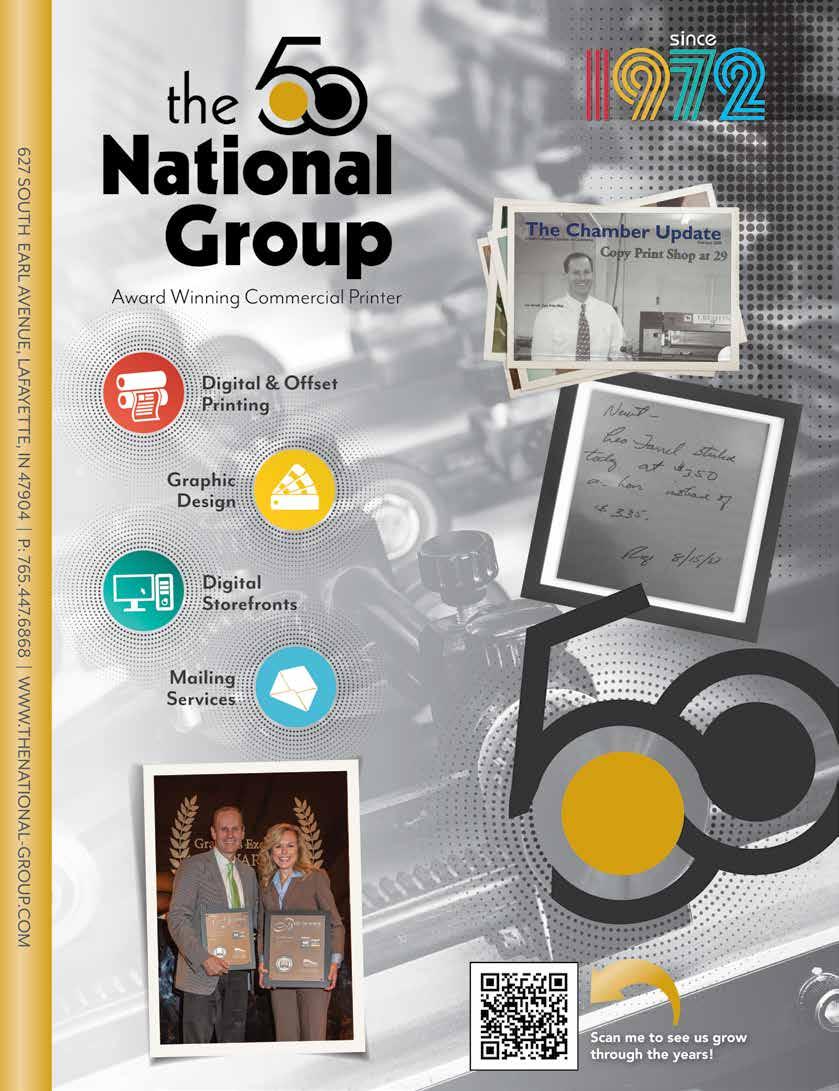 BY KEN THOMPSON PHOTOS PROVIDED
BY KEN THOMPSON PHOTOS PROVIDED
Tee time
Greater Lafayette home to world-class golfing experiences
Greater Lafayette offers several of Indiana’s finest golf courses. Thanks to the mild winter, the most avid golfers got a head start on the 2023 season.
A new year also brings changes to our seven courses, ranging from improving course and facility services to the Cherry Lane realignment project making an impact on availability at Purdue’s Birck Boilermaker Golf Complex.

Battle Ground Golf Club
A new club professional, Jackson Hillard, is among the changes that have taken place since last fall.
Hillard brings a decade of experience to Battle Ground, most of it spent at the Highland Lake Golf Course in his hometown of Richmond, Indiana
“Battle Ground had an amazing year last year, and I hope to be able to continue that trend,” Hillard says.
“While we are installing new cart path segments in the worst areas, we are also planting new trees and removing invasive ones. We have large plans to renovate our fescue/no mow areas with better seed to make the course a much smoother look.”
Battle Ground Golf Club opened on July 4, 1967, and resides on 160 acres neighboring Prophetstown State Park. It was the home of the Lafayette Country Club for nearly 50 years. While the original course design was by Robert Simmons, two decades ago the course underwent renovation under the guidance of world-renowned golf course architect Tim Liddy.
The club’s course favors every level of golfer, with wide bent-grass fairways offering multiple target lines. Sizable greens and large surrounding areas leave open an array of possible shots from close range. Longer hitters will be challenged by thick rough and strategically placed bunkers. Water comes into play on three holes.
Five sets of tees allow the course to play from 5,100 to nearly 7,100 yards. Amenities include a putting green, a short game arena and a practice tee equipped with five target greens.
Information on daily fees and/or memberships can be found at golfbattleground.com.
Birck Boilermaker Golf Complex
It will be an unusual spring and summer season at the Purdue courses due to road construction.
The Ackerman-Allen course is open for public play, but access will be from Cherry Lane via Northwestern Avenue and then taking a left onto Steven Beering Drive. A bag drop and operations trailer will be located between the golf course and Ross-Ade Stadium’s “R” lot.
Due to limited access and parking, the Kampen-Cosler Course is limited to Birck Boilermaker Golf Club members and members of the Purdue golf teams until further notice. Guests may play only when accompanied by a member.
Legendary golf course designer Pete Dye oversaw the creation of both courses. Ackerman-Allen is a par-72 championship golf course featuring large bent-grass greens and fairways. The challenges for golfers come from the rolling hills, tree-lined fairways, white sand bunkers and a few water hazards. Five sets of tees play from 5,300 yards to the championship tees playing more than 7,500 yards.
Rated one of the top collegiate courses in the nation, Kampen-Cosler has been awarded 4.5 stars on Golf Digest’s “Places to Play” and is ranked among the most difficult golf courses in Indiana.
It has been the site of the 2000 Men’s Big Ten Championship, the 2003 women’s NCAA Championship, the 2004 Indiana Open, the 2005 Women’s Western Amateur and the 2008 men’s NCAA Championship.
When it’s open for public play, Kampen-Cosler challenges golfers of all experience levels. Vast sand bunkers, native grasslands, ponds and a natural celery bog lead up to large bent-grass greens. Five sets of tees offer a playing range from 5,300 to more than 7,400 yards.
To book a tee time, see rates and to get construction updates, visit purduegolf.com.
Coyote Crossing
“GolfWeek” calls Coyote Crossing the sixth-best course you can play in Indiana, and for good reason, says Brent Wills, president/general manager/director of golf.
“The course’s creative layout through the natural terrain, the improved turf quality for ideal playing conditions, the relaxed, player-friendly atmosphere and the camaraderie within the
54 GREATER LAFAYETTE MAGAZINE




GREATER LAFAYETTE MAGAZINE 55 stuartlaw.com | 765.423.1561 LOCAL COUNSEL Since 1878 Battle Ground Golf Club
Birck Boilermaker Golf Complex
large and growing membership is what makes Coyote Crossing Golf Club special,” Wills says.
Coyote Crossing was the dream of local businessman Randy Bellinger, who teamed up with Hale Irwin Golf Design in 1998. The course opened on June 7, 2000.
“Hale was fully involved from the design process through completion of construction of the course,” Wills says. “Coyote Crossing’s features epitomize Irwin’s design philosophy of incorporating two critical design elements: the existing environment and land planning objectives.”
Built on the rolling terrain around Burnett Creek and within the Winding Creek neighborhood, Coyote Crossing maintains much of the wildlife, native prairies, wetlands and forests while still challenging every club in a golfer’s bag.
A semi-private golf club since 2017, Coyote Crossing logged a record number of rounds played in January and February thanks to the mild winter.
Mild temperatures also allowed director of grounds Mike Dunk and his crew to rebuild the 10 cart bridges as well as the four walking bridges on the course. Coyote Crossing has added a new fleet of 2023 EZGO Elite golf carts with just about every imaginable extra: comfortable premium seats, USB charging ports, windshields, sun canopies, rain covers for golf bags, sand bottles and beverage coolers.
Other improvements from the 2022 season include a revamped menu and food service at its restaurant/bar, the addition of fiber internet service at the clubhouse and a new floor installed in the pro shop.
Coyote Crossing is scheduled to host an IHSAA boys golf regional in June, the Indiana Girls

56 GREATER LAFAYETTE MAGAZINE
State Championship in July and the Indiana Women’s Senior Golf Association state tournament. Annual memberships are available and daily greens fees begin at $49 for 18 holes, including a cart. Tee time reservations are available online at CoyoteCrossingGolf.com.

“We would like to invite you to experience everything that Coyote Crossing has to offer, whether it’s as a new member, for a fun round of golf, to enjoy a casual dining experience or to host a banquet or event,” Wills says. “We are certain that you will have a memorable experience and will want to return again and again.”
Lafayette Country Club
The oldest golf course home in Greater Lafayette was founded from a simple question.
“Why doesn’t Lafayette have a golf course?” Purdue Athletic Director Hugh Nicol asked prominent Lafayette lawyer William V. Stuart in 1909.
Spurred by that question, Stuart teamed up with other prominent citizens to plan a family-friendly club complete with golf course and other recreations on what was once known as “Reynolds Pasture.”
This information comes from “A History of the Lafayette Country Club – Celebrating Tradition, 1909-2009,” by Joanne P. Willis.
Today, it’s not uncommon while driving on South Ninth Street to watch members play the 9-hole golf course.
“The mild winter has allowed our members to get out for a few rounds without too much issue,”
GREATER LAFAYETTE MAGAZINE 57
Coyote Crossing
General Manager Alex Smith says. “With our course being smaller and since it has been here for so long, it’s not too tricky to get it ready to play. Our groundskeepers maintain it year-round, so we are usually ready to go when we have nice weather.”
The members-only facility also has a pool and tennis courts as well as a dining room. For information about joining the Lafayette Country Club or booking its facilities for weddings or other celebrations, visit lafayettecountryclub.net.
The Ravines
Originally a family farm that has been in the Ade family for nearly 150 years, The Ravines was conceived in early 1994 and opened in June of 1995.
“It’s been a financial rollercoaster ride for 28 years, but we’ve survived and are doing well,” Ed Ade says. “We offer a very good product at a very fair price. It’s a family business. We try our best to make a round of golf at The Ravines an enjoyable family experience.”
The course provides two different 9-hole styles. The front 9 is longer and more open, with water, sand traps and mounding in play. Golfers then are challenged by a tighter, shorter back 9 with deep ravines to play over and around.
“All in all, it’s a fun course to play for golfers of all abilities,” Ade says.
Green fees have increased for 2023 due to increased costs for chemicals and fertilizer, as well as items inside the pro shop, Ade says.
“We’ve tried to keep our green fees low throughout the years, raising the fees slightly if at all,” he says. “Our goal is to keep the course in an upscale condition yet keeping our prices low, a good value for the money.”

The Ravines is now offering online booking at golfravines.com, but Ade says golfers may still call 765-583-1550 or 765-497-PUTT (7888) for tee times.

58 GREATER LAFAYETTE MAGAZINE
West Lafayette Golf and Country Club
Memberships also are available at The Ravines for golfers who want to play 25, 50, 75 or more times per year. The Ravines offers a clubhouse and pavilion that is available for weddings, company outings and other events.

“If you haven’t played The Ravines, give us a try,” Ade says. “We think you’ll enjoy your experience.”
West Lafayette Golf and Country Club
It’s been almost 10 years since The Elks Country Club became the West Lafayette Golf and Country Club.
At its longest, WLGCC is a par-71, 6,256-yard course. The course rating is 70.4, and it has a slope rating of 120 on rye/bluegrass/bent grass.
In addition to winning a Reader’s Choice award from the Lafayette Journal & Courier, WLGCC has emphasized service to its members. The semi-private club also welcomes the public. Visit wlgcc.com to reserve tee times or to become a member.
WLGCC is home to club professional Joel Baumgardner’s Golf Academy (joelsgolfacademy. com), which provides clinics and instruction for all ages.
Be sure to check out the club’s “Annual Fabulous Fourth of July Celebration.” The family event is open to the public.
WLGCC also has a scenic banquet facility that is available for wedding receptions, parties, professional gatherings, charity events and other festivities. For more information, contact Julie Schremp at 765-463-2332. ★
GREATER LAFAYETTE MAGAZINE 59





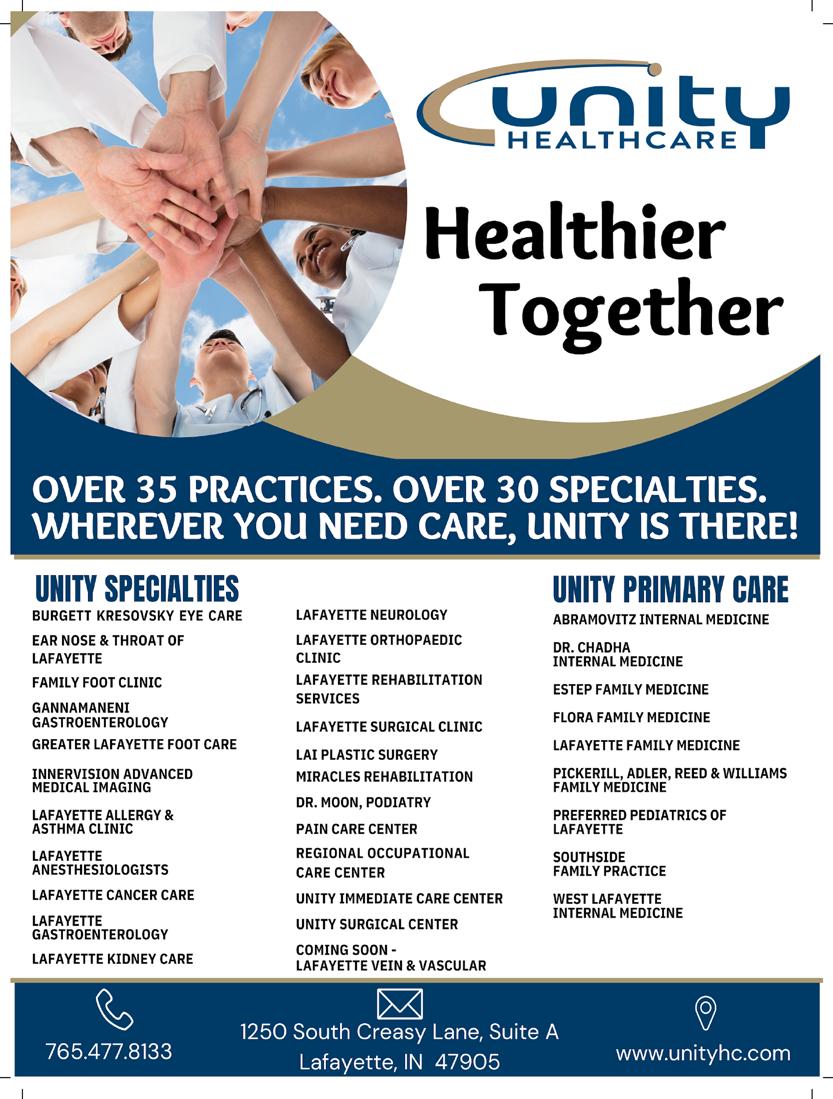

62 GREATER LAFAYETTE MAGAZINE
BY JILLIAN ELLISON PHOTOS PROVIDED
In 2020, during the thick of the COVID shutdown and the shift to working from home, it wasn’t uncommon for employees across the United States to look at their remote work situations and wonder if they could find a better job fit elsewhere. Freed from the confines of their cubicles, for thousands of workers the idea of relocation to a new city was planted.
The Greater Lafayette area found itself the destination for many job seekers as the two cities began to receive accolades for their entrepreneurial atmosphere, world-class Purdue University and affordability. Among those accolades: a recent Wall Street Journal report that ranked Lafayette as the fifth best place to live for remote workers. That ranking was based on a poll that identified 10 factors people said they most cared about in a remote-work setting. Key factors included high-speed internet, housing prices, cost of living, employment and arts and entertainment venues and parks.
An additional lure for remote workers arose in April 2022 when Purdue University announced a first-of-its-kind program, not only inviting remote workers to move to the Greater Lafayette area, but to pay them to move as well.

If a $5,000 moving stipend wasn’t appealing enough, a few other perks were included: a Purdue ID card, permitting access to campus libraries and free rides on City Bus; free membership to care.com; a 50 percent discount to the Convergence co-working space on campus and a discounted membership to Parkwest Fitness. The program ended in February after seeing a significant wave of applicants, but the program’s success signaled to stakeholders just how desirable the Greater Lafayette area is for remote workers.
Vanessa Hughes and her husband, both post-production television editors from Burbank, California, saw what the Wall Street Journal wrote about after just one brief visit.
The couple’s first experience in Greater Lafayette came in May 2022, when they stayed in the area while attending the famed Indianapolis 500.
“Before we left for the trip, my husband joked that I might fall in love with Indiana and we’d have to move here,” Hughes says. “Once we got here, I really liked the area and started looking for rentals, out of curiosity.”
It wasn’t long before she began seeing social media ads promoting work-from-home opportunities in the Greater Lafayette area with appealing incentives for remote workers to pick up their belongings and make the leap from the West Coast to the Midwest.
GREATER LAFAYETTE MAGAZINE 63
Remote workers find Greater Lafayette an easy place to call home
Once Hughes and her husband identified a viable time to make the move, she says they jumped on Zillow.com, cruising for a rental that fit their needs. Despite Tippecanoe County’s tight housing market, the couple was able to find a rental home in West Lafayette in just a few weeks.
Though they’ve only been in the area since November, Hughes says the vast amount of entertainment, access to university and community libraries, green spaces and friendly neighbors have made them feel at home in no time.
“I really appreciate the events calendar that Purdue Research Foundation puts out,” she says. “It’s daunting to move to any new place, and having an easy way to network and meet people is wonderful.”
A homecoming
For Ben Carson, however, the decision to move to West Lafayette as a remote worker was different: it was choosing to come back home.
Carson, a competitive debate coach and product developer for online academic competitions, moved from the Greater Lafayette area to New Jersey five years ago as a full-time debate coach, but as the pandemic shifted work online for many employees, Carson was looking for a change.

“With changing jobs, it made my ability to be remote, and to do that from anywhere was freeing, and I didn’t feel tied down to New Jersey anymore,” he says. “I was looking for different settings, but at that time coming back home made sense.”
Carson made his move in November, and like Hughes and her husband, he found himself in a lucky spot. He landed an available
one-bedroom apartment at the Provenance Apartments in Purdue’s Discovery Park.
In five years’ time, Carson says one of the most visible changes he’s seen in the Greater Lafayette area has been the rapid development of the Discovery Park District, an area of the university’s campus that has seen more than $1 billion in development through the addition of housing, research facilities and commercial properties.
“At the time when I left, none of what is there now existed,” he says. “Now, it’s completely unrecognizable having not seen the growth in real time, but seeing that area being taken advantage of to its fullest extent is really great to see.”
Moving back to Indiana, Carson says he didn’t expect many surprises having lived here most of his life. Knowing Tippecanoe County has been a hotbed for development over the last decade, he expected to see some businesses he didn’t recognize and some buildings to look a bit different, but he was reminded of one thing as the seasons changed.
“I kind of forgot how windy it is here,” he says. “I didn’t really realize it and didn’t think much about it when I moved to New Jersey, because for the most part the weather is the same. But man, getting hit with that wind kind of took my breath away.”
Moving from California to Indiana, Hughes says her biggest surprise came after seeing the state’s famed breaded pork tenderloin sandwich.
“I am surprised by just how large a pork tenderloin sandwich can actually be,” she says. “I respect it, but I will stick to a spicy chicken sandwich instead.” ★
64 GREATER LAFAYETTE MAGAZINE
"At the time I left, none of what is there now existed. Now it's completely unrecognizable having not seen the growth in real time, but seeing that area being taken advantage of to its full extent is really great to see."






GREATER LAFAYETTE MAGAZINE 65 W E A R E C O M M I T T E D T O G U I D I N G O U R C L I E N T S B Y O F F E R I N G P R O A C T I V E A C C O U N T I N G A N D B U S I N E S S S O L U T I O N S T O S I M P L I F Y T H E I R L I V E S A N D G R O W T H E I R P A S S I O N S . M O N T H L Y A C C O U N T I N G S E R V I C E S T A X P R E P A R A T I O N A U D I T I N G & A T T E S T A T I O N R E T I R E M E N T P L A N N I N G & A D M I N I S T R A T I O N E S T A T E P L A N N I N G O U T S O U R C E D C O N T R O L L E R & C F O S E R V I C E S W H A T W E C A N H E L P W I T H : L A F A Y E T T E 4 1 5 C O L U M B I A S T 7 6 5 - 4 2 8 - 5 0 0 0 R E N S S E L A E R 3 1 1 E A S T D R E X E L P A R K W A Y 2 1 9 - 8 6 6 - 5 8 3 5 W W W . H U T H T H O M P S O N . C O M
Vanessa Hughes (left) and her officemates Hank (top) and Bobby.

66 GREATER LAFAYETTE MAGAZINE
Chefstheirsharefavorite spring recipes
With spring, green will start to sprout in your yard, garden and, according to Greater Lafayette chefs, on your dinner plate. Green signifies renewal and deliciousness as ingredients such as asparagus, broccoli, basil and spinach come into season and into some savory recipes for you to try by Greater Lafayette chefs.
Cody Hall Digby’s 133 N. Fourth St.
Along with his chef’s hat, Cody Hall wears the figurative general manager’s cap at Digby’s, a popular downtown Lafayette pub and grill. For the past six months, Hall has revamped the menu, adding diverse options to go along with Digby’s staples of burgers and those gonzo fried cheese bricks.
Hall’s light pasta dish is packed with flavor as well as fresh asparagus and shiitake and/or morel mushrooms. These primary ingredients are easily grown in Indiana.

“When I think about cooking, the first thing I consider is always seasonality and locality,” says Hall, adding that the following dish is being considered for Digby’s menu. “The best ingredients come from somewhere close. To me, early spring in Indiana is asparagus and morel mushrooms.”
Mushroom and Asparagus Linguine
(Makes 4 servings)
• 2 cups sliced mushrooms
• 1 lb. dried linguini
• 1 lb. fresh asparagus
• 1 cup heavy cream
• 1 cup parmesan cheese
• 1/2 cup sliced leeks
• 1/2 cup white wine
• 1/4 cup cooking oil
• 2 tablespoons chopped fresh garlic
• 2 tablespoons chopped basil
• 1 tablespoon chopped parsley
• 1 tablespoon lemon juice
• 1 tablespoon butter
• 2 teaspoons salt
• 2 teaspoons black pepper
Wash and dry produce; if using morel mushrooms, soak in salted water for 20 minutes. Slice mushrooms and leeks; set aside.
Chop garlic, basil, parsley and asparagus; set aside. Measure out heavy cream, parmesan, wine, oil, lemon juice and butter.
In a large stock pot bring four liters of heavily salted water to boil. Cook linguine to package instructions. When draining pasta, reserve 1/2 cup of cooking water.
While waiting for water to boil, add cooking oil to large sauté pan and turn on medium-high heat. When oil is hot, add leeks and sauté until they start to brown, stirring occasionally.
Add mushrooms; season with salt and pepper. When the mushrooms have cooked through, add asparagus and sauté asparagus until cooked through about 75% and then add garlic. Cook garlic until it starts to brown and stick to the pan. Stir in wine and lemon juice and bring to a boil. Simmer about three minutes and add heavy cream.
When the heavy cream comes to boil, stir in parmesan and butter.
When the sauce thickens and becomes smooth, add reserved pasta water and cooked pasta. Toss to mix well and serve.
Garnish with fresh herbs and parmesan.
GREATER LAFAYETTE MAGAZINE 67
STORY AND PHOTOS BY TIM BROUK
Same-Day Dough for Cast Iron Skillet Pizza
(Makes three dough balls, each about 9.5 ounces.)
Start this recipe in the morning for pizza in the evening. This process takes approximately 10 hours from mixing to eating.
Helpful tools: thermometer, kitchen scale, stand mixer, bench scraper, wooden pizza peel
• 2 teaspoons fine sea salt
• 1 1/2 cups water at 55 degrees
• 1/32 teaspoon active dry yeast (just a pinch)
• 3 2/3 cups King Arthur bread flour
To mix and knead:
Dissolve the salt in the water in a large mixing bowl. Add the yeast and stir until dissolved. Gradually mix in the flour until a shaggy dough is formed.
With your hands, knead and fold the dough onto itself for 10-15 minutes. It will be very sticky at first but will feel less wet as the flour continues to absorb the water. Do not add more flour. Trust the process and scrape as much dough from your hands as possible as you go.
(If you have a stand mixer, you can skip the kneading by hand and mix the dough on low speed for 15 minutes.)
Kat Holaday
Snuggs Pizza and The Spot Tavern
409 S. Fourth St.
After a winter of Detroit-style(ish) “grandma slices,” Snuggs Pizza fully blooms in the spring when its patio wood-fired oven is ignited. Full pizzas are paddled in and out starting this month through October.

A newer but significant player in the local pizza scene, Snuggs’ recipes feature ingredients grown at The Spot. The Lafayette watering hole grows its own greens — chard, spinach, arugula, broccoli and basil — and tomatoes. Most of these ingredients are featured on the summer favorite Greens Pizza on the Snuggs wood-fired pizza menu.
Holaday credits the doughmeisters at Smittybread in the formulation of the pizza crust, which is a sourdough base.
“It’s naturally leavened,” Holaday says. “We put a lot of our love and energy into our doughs.”
The pizzas are baked at 900 degrees, and the menu is always changing depending on peak ingredient timing and availability.
After kneading and folding, the dough should feel plump and springy when poked.
To ferment:
Cover your bowl with a kitchen towel or plastic wrap, and let the dough ferment at room temperature (ideally 70 degrees) for six hours.
Ball up dough and second ferment:
At this point, the dough will be plump and springy.
Lightly flour your hands and bench scraper. There’s no need to flour your dough or work surface: That will only make the dough stiff.
Dump your dough onto a dry work surface using your hand to scrape it from the bowl.
Cut and divide the dough into 3 equal pieces.
Shape the dough into a ball using your hands or bench scraper by pulling the dough towards you with resistance on the work surface; then rotate a quarter turn and repeat the pulling process until the dough forms a tight ball and is smooth on the top.
Once the shaping is complete, transfer your dough balls to a flour-dusted sheet pan, spacing your dough balls out so they have room to spread without touching.
68 GREATER LAFAYETTE MAGAZINE
Lightly spray plastic wrap with non-stick spray and cover the dough. Let the dough balls rest at room temperature for three hours.
Shaping and baking:
Begin this process when you have one hour left of the second fermentation.
Set an oven rack six inches below the broiler.
Preheat the oven to its highest temperature (usually 500550 degrees) for 45 minutes.
When the oven is preheated and you are ready to bake, set the oven to broil.
Heat a large cast-iron skillet (12-14 inches) on the stovetop over medium-heat for 3-5 minutes.
Lightly flour a work surface and pizza peel, and gently remove a dough ball from the tray onto the floured surface.
Starting in the center of the dough, lightly push down and outward to form a round shape, leaving a half-inch outer edge to form the crust.

Once the dough is roughly a seven-inch disk, gently pick it up and drape it over your fists. Move your fists around the circle allowing gravity to stretch the dough as you turn it.
Once the dough is around 11-12 inches, place it on the lightly floured peel and gently tug the edges to reshape it into a circle.
Give the peel a quick shake to be sure the dough isn’t sticking. If it is, gently lift the sides and dust flour under the dough until it moves freely on top of the peel when you shake it.
Your oven should be set to broil, and your cast iron should be smoking hot on the stovetop.
Slide the shaped dough from the peel into the cast iron. Using an oven mitt, quickly shake the cast iron to center the dough.
Turn the heat to low and top your pizza.

Put the cast iron in the oven under the broiler and cook until the crust is puffy and beginning to char in 2-4 minutes.
Rotate the pan during baking for even cooking.
GREATER LAFAYETTE MAGAZINE 69
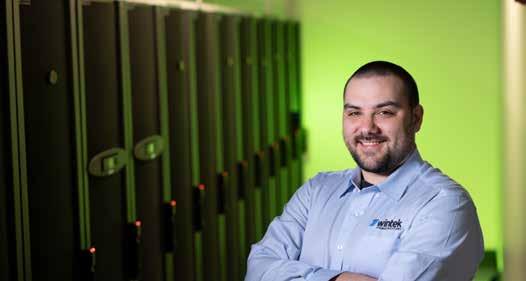


70 GREATER LAFAYETTE MAGAZINE Ivy+ Career Link serves our community by partnering with key economic sectors to deliver demand-driven, student-centric, real-world results. IvyTech.edu/Workforce • bburton65@ivytech.edu • ( 765) 269-5877 Career Link
Ake Waratap
Thai Essence 1534 Win Hentschel Blvd.
A spring menu staple for Thai Essence is a bouquet of healthy, fresh flavors and textures, also known as the Mango Salad. The dish features a semi-ripe mango sliced into strips.

“The semi-ripe mango has a bit of a crunch,” Waratap explains. “A really ripe mango is going to be too soft.”
The salad’s protein comes in the form of chicken and shrimp, with tofu as a meatless option.
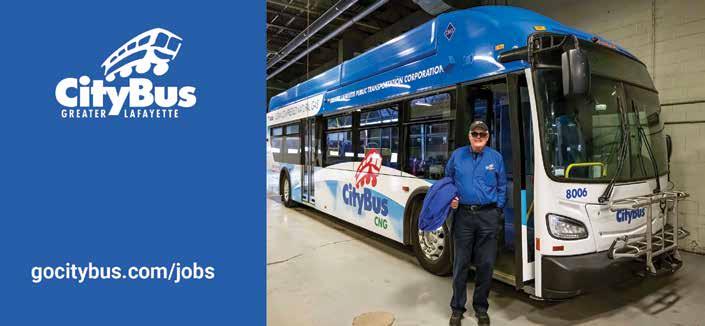
Much flavor comes in the form of the salad’s spicy dressing. Waratap doesn’t drizzle it on top, though. The shrimp and chicken are cooked with the dressing. The spicy flavors are absorbed into the protein.
The heat is balanced with iceberg lettuce, green onions and cilantro — as well as the sweet, sweet mango.
Mango Salad
Waratap rarely measures his ingredients. His eyes and taste buds are his guides, but he assures the mango salad is customizable. It’s up to the home chef how spicy or how much protein to put in.
• 1 semi-ripe mango, cut into strips
• Iceberg lettuce
• Chopped cilantro, red onions and green onions
• Shrimp and sliced chicken
• Toasted coconut flakes
Dressing includes fish sauce, brown sugar, fresh lime juice and red chili flakes.
In a pan, boil a shallow amount of water. Once boiling, add shrimp and chicken.
While the protein cooks, mix dressing ingredients then pour into the pan.
While it’s cooking, assemble the salad, starting with lettuce then the chopped herbs, onions and sliced mango.
Top with cooked chicken and shrimp and dust with toasted coconut flakes.
GREATER LAFAYETTE MAGAZINE 71
Best corner office in town.
Lauren Reed Lafayette
Reed has cooked for former U.S. Secretary of State Condoleezza Rice at a gala event, as well as hungry, rabid football fans and former NFL players at several Super Bowls. The Lafayette chef gained a local following from her farm-to-table dinners at Prophetstown State Park.
Today, she is head chef for a Purdue University sorority. While college students are a different audience than those at football games and state parks, Reed’s kitchen prowess and creativity have won over her house of young Boilermakers.

To celebrate spring, Reed reached back to her Prophetstown days to reintroduce her Spring Asparagus and Orzo Salad.
“Asparagus is the best vegetable, in my opinion,” Reed says. “The dish has roasted asparagus with a lemon-garlic dressing. There’s some feta cheese in there, sun-dried tomatoes, and it’s topped with microgreens. It’s very light, refreshing. It’s just a way to welcome spring.” ★
Spring Asparagus and Orzo Salad
(Serves 6-8)
• 2 cups dry orzo
• 1 bottle Garlic Expressions dressing
• 1 bunch fresh asparagus
• 1 English cucumber, diced
• ¼ cup sun-dried tomato, chopped
• ½ cup feta or goat cheese, crumbled
• 1 bunch fresh parsley, chopped
• Juice of ½ a lemon
• Salt and pepper to taste
• Microgreens to garnish
Cook orzo to package directions until al dente. Drain and cool.
Grill or lightly roast asparagus spears for three minutes. Cool and chop.
Mix orzo, asparagus, cucumber, cheese, tomato and parsley. Stir in dressing and lemon juice.
Season with salt and pepper to taste.
Let salad rest in refrigerator at least an hour before serving. Top with microgreens.
72 GREATER LAFAYETTE MAGAZINE







74 GREATER LAFAYETTE MAGAZINE THEBRYANTWL.COM RED7GRILL.COM LITERATOCAFE.COM CHRISTOSGRILL.COM PROUDLY SERVING OUR NEIGHBORHOODS FOR MORE THAN 30 YEARS

GREATER LAFAYETTE MAGAZINE 75
BY MEGAN FURST PHOTOS BY CHRISTINE PETKOV
Top 10 Under 40
Shining examples of young, community-minded servant leaders
Greater Lafayette Young Professionals, formerly Tippy Connect, recognizes and celebrates young professionals each year who make a difference in the Greater Lafayette community. The Top 10 Under 40 award winners are shining examples of individuals who share creativity, vision and passion for the community where they live and work.
Dating back to 2007, the awards begin each fall with an open invitation to the community to submit nominations of young professionals under 40 years old deserving of the honor.
A selection committee made up of individuals representing Greater Lafayette Commerce, Greater Lafayette Young Professionals, the business community and past winners, reviews the nominees. Winners are chosen based on high scores from the following areas: servant leadership, community involvement and excellence in professional development.
“Our winners have always included exceptional individuals,” says Shelby White, content marketing specialist for Greater Lafayette Commerce and co-chair of the Top 10 Under 40 selection committee. “Past recipients include community and industry leaders such as Jacqueline Chosnek, Erin Easter, Jen Edwards, Tetia Lee, Julie Hendon and Andy Gutwein. So, the bar is and always has been set high for our winners.”
Once selected, the winners are notified and invited to attend the Greater Lafayette Commerce Annual Celebration. The 2022 winners were recognized at the event in October.
“It was incredible to see what people have accomplished in their careers at such a young age. We had CEOs, young people managing recovery programs, running nonprofits that feed and clothe families, and companies creating jobs,” White says. “And it was great to see their genuine surprise and appreciation at winning the award, because that’s not something that happens every day.”
Here’s a brief introduction to the 2022 winners.
76 GREATER LAFAYETTE MAGAZINE
Alex Johnston
Facility Planning & Sales, Titan Construction & Engineering Services

With his background in construction and strong faith, Johnston serves his community through his work, church, student athletes and neighbors. He’s always willing to help, plan and serve others. Johnston earned his bachelor’s degree in technology resource management from Southern Illinois University. What is the most valuable lesson you’ve learned in your career so far?
Don’t allow yourself to stop learning and growing. Continuing to grow presents opportunities for humility, leadership, open communication and relationship building. When we become stagnant in our knowledge is the moment others pass us by. Allow yourself to learn and grow.
What do the next 10 years look like for you?
Working in such a well-established company like Titan Construction and Engineering Services, there is not a lot of turnover. I see opportunities within the next 10 years to grow our client relationships and pursue new project opportunities.
As for me, Titan will be home for a long time. This company is a great fit for my family and me. The relationships I have come to hold dear to my heart are ones I wouldn’t trade for the world. As for growth in my community, Lord willing, I will continue to hone my skills as a servant leader and find ways to better educate our youth about the opportunities in the construction trades. What is the best part about working and living in Greater Lafayette?
Growing up in a small town, Lafayette seemed like a big city when I first moved here. I have learned that big cities can still have that small-town feel when you have the motivation to network with others, get to know and love your neighbors and, most importantly, get involved in a local church.
Lafayette has opportunities for every age and ability. Our community is full of passion and growth, whether recreationally, professionally or socially. I love my city and couldn’t imagine raising my family anywhere else.
GREATER LAFAYETTE MAGAZINE 77
Jennifer Million
Chief Operating Officer, United Way of Greater Lafayette
Million has served the community through various roles with the United Way of Greater Lafayette since 2010. She started with the Volunteer Income Tax Assistance (VITA) program and was recently promoted to chief operating officer. Million earned a bachelor’s degree in public financial management from Indiana University and an M.S. in accounting from DeVry University.

What is the most valuable lesson you’ve learned in your career so far?
Find a career that you are passionate about, and it will motivate you to be your best. There is a lot of talk about finding a work-life balance, but the reality is that work is a part of life, a big part of it for many people. If you’re going to have to be away from your families to make a living, why not spend that time doing something you love and that you find fulfilling and doesn’t just feel like work?
I never knew I needed to spend my career giving back to our community. Yet, after spending the last 12 years doing precisely that, I can’t imagine doing anything else. I know that it isn’t that simple for everyone, and I also know how fortunate I am that I stumbled into a career that is fulfilling both personally and professionally. I would love for everyone to find that for themselves, too.
What do the next 10 years look like for you?
While I don’t know where I’ll be in the next 10 years, I hope to continue to make a significant impact in my community, helping to improve the lives of others. I have been blessed to develop and grow in a career that I love, and I hope that I have the opportunity to continue to build upon that in the future.
What is the best part about working and living in Greater Lafayette?
There are so many wonderful things about Greater Lafayette — it’s hard to settle on just one best part. I love most the opportunity to develop meaningful relationships with many different people in our community: from community partners and business leaders to volunteers. The people in this community are what make it such a great place to live and work.
78 GREATER LAFAYETTE MAGAZINE
Tracy Fuller Executive Director, Hanna Community Center Director, Indiana Minority Health Coalition of Tippecanoe County
With a background in programming, event management, sponsorship, fundraising and sales, Fuller leads with passion and experience, serving as a voice and advocate for those in need. She earned a bachelor’s degree in media arts and animation from the Illinois Institute of Art and an M.S. in sports management and recreation from Indiana State University.

What is the most valuable lesson you’ve learned in your career so far?

The most valuable lesson I have learned in my career is that to make a change affecting those in the community you serve, you have to be the change. After all, there can be multiple solutions to fix a need, and the more information you have, you can decide to implement a change.
What do the next 10 years look like for you?
In the next 10 years, I will grow both personally and professionally. I will continue to serve the community that is Greater Lafayette through advocacy, programming, fundraising, grants and donation security. I hope to remain in the non-profit industry and would be blessed to be CEO one day.
What is the best part about working and living in Greater Lafayette?
The best part of working in Greater Lafayette is that you get to interact with those that you serve. You see the difference in their lives because of what you helped accomplish, which is absolutely priceless.

GREATER LAFAYETTE MAGAZINE 79
Timothy Atwater
Midwest Area Post Collections Manager, Republic Services
Atwater believes in servant leadership and strives to leave his community in better shape for the future. He is a 13-year U.S. Navy veteran and serves as the site coordinator for the VA Medical Centers in Chicago and Indianapolis, including their associated VA Clinics in Lafayette and West Lafayette. Atwater earned a bachelor’s degree in mechanical engineering technology from the University of Nevada Las Vegas, a B.A.S. in sustainability management from St. Petersburg College and an M.B.A. from Texas A&M University.

What is the most valuable lesson you’ve learned in your career so far?
The most valuable lesson I have learned in my career is that complacency is an illness in the professional world. To succeed continuously, you must learn, change and adapt constantly. This is not to say that you shouldn’t have a good work/life balance — because you absolutely should. But if you manage your time wisely, you can be highly successful personally and professionally.
What do the next 10 years look like for you?
In the next 10 years, I see myself in a high-level corporate role. I am in a mid-level corporate position currently, but in 10 years I think I can reach executive status if I keep working hard and continue to be an invaluable asset to my company. This is obviously a stretch goal I have set for myself. That said, I am in no rush to get there and enjoy the climb to the top one step at a time.
What is the best part about working and living in Greater Lafayette?
The best part about living in Greater Lafayette is the heightened sense of community. I have lived in many different cities and towns across the country, and Lafayette ranks number one to me in mass community involvement and outreach. It’s a small town with a big heart. The city keeps the community close by having different festivals, parades and events throughout the year. Living in Lafayette will give anyone a sense of “home,” whether they are from the town initially or are a transplant like me.
80 GREATER LAFAYETTE MAGAZINE
Tristen Comegys
Chief Executive Officer, Bauer Family Resources
Aside from her leadership position at Bauer Family Resources, Comegys serves others in numerous ways, including tackling homelessness, food insecurity and promoting early childhood development. She is a United Way volunteer and a board member for the Carroll County Chamber of Commerce, Healthy Communities for Clinton County, Highland Heights Foundation and Clinton County Chamber of Commerce. Before leading Bauer Family Resources, Comegys was the chief executive officer for Clinton County Family YMCA. Comegys earned a bachelor’s degree in communications and advertising from Purdue University Northwest.

What is the most valuable lesson you’ve learned in your career so far?
The most valuable lesson I have learned in my career so far is to ask the silly questions. I became a nonprofit CEO at 28 with limited leadership and business management experience, and I quickly discovered that I had a lot to learn. I overcame the challenges I faced by asking questions to the experts around me. Looking back, many of those questions probably appeared novice to that expert; however, their insight allowed me to gain a better understanding and knowledge base more quickly. You can’t be afraid to be vulnerable when you don’t have the answer because it prevents you from getting the solution to help overcome something.
What do the next 10 years look like for you?
Within the next 10 years, I plan to earn my master’s degree in organizational leadership and design with the future goal of teaching at a university. Regardless of my career’s direction, I plan to continue serving the community as a leader, volunteer and donor.
What is the best part about working and living in Greater Lafayette?
The best part about working in Greater Lafayette is the extensive network of leaders and resources we have access to. Additionally, the best part of living in Greater Lafayette is the amenities: parks, downtown and easy access to neighboring communities.
GREATER LAFAYETTE MAGAZINE 81
Rebecca Jones Laughner
Vocational Rehabilitation Counselor, State of Indiana Owner, Eclectic Beauty + Fashion Founder, Ladies Lunch Network

Since age 12, Jones has been a community activist, empowering and helping others. Jones has served in leadership roles for Greater Lafayette Young Professionals, Tippecanoe Arts Federation, Purdue Extension Community Action Program and Pride Lafayette. She also founded the Ladies Lunch Network in 2022, a grassroots organization with more than 450 members to connect women in Greater Lafayette. Jones has an A.S. in liberal arts and early childhood education, a bachelor’s degree in human services and M.S. in management and organizational leadership.
What is the most valuable lesson you’ve learned in your career so far?
The most valuable lesson I’ve learned throughout my career is that failure is an essential part of growth and success. Mistakes are inevitable, but it’s important to learn from them, adapt and keep moving forward.
Taking risks and stepping out of your comfort zone are essential to achieve your goals. Being open to feedback, continuously learning, and developing your skills are crucial growth mechanisms in any field. These skills help with professional and personal growth and lay a foundation for future connections, as they are the core requirements for constructing insight and experience.
82 GREATER LAFAYETTE MAGAZINE
What do the next 10 years look like for you?
Looking back over the last 10 years, I barely recognize myself in the growth I’ve encountered. I can imagine the next 10 years being similar. I am a huge proponent of community-centric programming and know that it is inevitable that I will land somewhere where I can continue to build on this passion.
Over the course of my career, I have realized that the broad spectrum of work is supported by niche positions laser-focused on a specific development. Using this understanding, I would like to continue to dig out my niche in programming and development to support the topics I have become undeniably passionate about — including young professionals, women empowerment and community engagement.
Looking back in 10 years, I hope that I am still supported by my work and community in locating and developing these opportunities in impactful ways.
What is the best part about working and living in Greater Lafayette?
One of the best parts of living in Greater Lafayette is the strong sense of community and the welcoming approach to new ideas and innovation. Opportunities, large or small, are meant to thrive here. It’s easy to feel like you’re in a small town — and the connections made truly reflect that.
It is impossible to have a small circle when it’s so easy to know everyone — and equally easy to cheer them on while celebrating their wins. I often say that I moved here for the opportunities and stayed for the community. It is a great place to live and work for those who want to grow their network, future and themselves.
Karissa Mooney
Financial Advisor, Edward Jones
Mooney has worked as a financial advisor at Edward Jones for more than 10 years. With a lifelong passion for helping others, she prides herself on serving as a partner and mentor to her clients through empathy, strategy and dedication.

Mooney is an active member of the Rotary Club of Lafayette, the Association of Women Business Owners and 100+ Women Who Care. She also serves on the development committee for the Community Foundation of Greater Lafayette and is a member of their Gold Key Advisors.
Mooney earned her A.S. and A.A. at Rend Lake College and her bachelor’s degree in business administration with a concentration in finance at Truman State University.
(Mooney's responses were not available at press time.)
GREATER LAFAYETTE MAGAZINE 83
Nathan Hedrick President & Owner, PQ Talent Chief Financial Officer, Main Street MFG
After working in corporate positions, Hedrick decided to focus his energy and passion on helping others find a career. He has started four successful businesses, including PQ Talent, Hoosiers at Home, Card Payment Solutions and Main Street MFG. Since 2015, Hedrick’s companies have employed more than 150 people. He also serves on the board of directors for Leadership Lafayette and is heavily involved with their events and mission. Hedrick earned a bachelor’s degree in agricultural and biological engineering from Purdue University.

What is the most valuable lesson you’ve learned in your career so far?
We’ve been paying people for their hands for years, yet they would give us their hearts if we only asked. The tremendous responsibility of having employees is prioritizing people-centric leadership. We are responsible for being good stewards to help each employee be the best they can be. The impact of validating the worth of everyone on our team while still being focused on a common goal and a sense of fulfillment is invaluable. If our employees can go home feeling better about themselves, it can profoundly impact home life so they can be better husbands, wives, brothers and sisters.
What do the next 10 years look like for you?
In the next 10 years, I’ll hopefully still be making an impact locally, building great people and allowing them to have great families through current or new business, raising the level of our local economy.
What is the best part about working and living in Greater Lafayette?
We have a great community with employers actively involved in making the area a better place to live and raise a family.
84 GREATER LAFAYETTE MAGAZINE
Drew Smith
Owner, Smith IV Group
Marketing Manager, National Alliance on Mental Illness, West Central Indiana (NAMI WCI)
Smith leads area organizations in networking, relationship-building and public relations through the Smith IV Group. He facilitates open communication and collaboration to help build a more developed workforce and volunteer pool. Smith also serves in various volunteer positions for Greater Lafayette Young Professionals, Rotary Club Satellite and the Tippecanoe County Health Department. A graduate of Harrison College and Ivy Tech Community College, Smith served as an E4 specialist in the U.S. Army from 2008 to 2017.
What is the most valuable lesson you’ve learned in your career so far?
The most valuable lesson I’ve learned is patience. It’s still something I’m learning and will be a lifelong lesson.
What do the next 10 years look like for you?
The next 10 years look like more networking and connecting with businesses and community members. I hope to help the city find its identity as we continue growing. Greater Lafayette is my home, and I plan on residing here for the long run.

What is the best part about working and living in Greater Lafayette?
The people are by far the best part of Greater Lafayette. As cheesy as it sounds, I truly believe Greater Lafayette can be the catalyst of change for Indiana.
GREATER LAFAYETTE MAGAZINE 85



86 GREATER LAFAYETTE MAGAZINE
Nathaniel Metz
CEO and Owner, Phoenix Paramedic Solutions President, Indiana EMS Association Executive Director, EMERG
With a long list of community charity events and initiatives behind his name, Metz has been leading by example for other young professionals for several years. He was the youngest EMS director in the state when he accepted his first leadership position, and he hasn’t slowed down since. Metz studied education, psychology and sociology at Purdue University, health sciences and nursing at Ivy Tech Community College and paramedicine at St. Elizabeth School of Nursing.
What is the most valuable lesson you’ve learned in your career so far?
Little things, missteps or improvements add up to big things down the road. Patience is essential when you are building anything of impact. Whether it be your organization’s culture, building professional skills and capabilities in yourself or others, building your company or an impactful initiative ... all require patience.
Have an infinite mindset. There will never be a finish line, so stop running full speed toward one. My journey has shown me that patience is key. With patience, you also need perseverance because only some people want to see you succeed; not everyone can see your vision, nor have they seen the trajectory of where you came from.
I have found strength and perseverance within my team and peers. That can only come when you build trust by being authentic and vulnerable. So be you, be patient in your vision for your future, follow your heart, be humble, be hungry and be smart. Nothing of impact is done without the collaboration of others, so while the journey is yours… remember, this is a team game.
What do the next 10 years look like for you?
Honestly, I have no idea where I’ll be in the next 10 years. That’s not to say that I haven’t thought about it strategically and built plans and proformas for where I plan on taking myself or my organization. I have and often do.
That being said, I put less weight on those these days, as I have found that if you follow a mission based on a set of core values that can be directed toward projects that fulfill you, doors will open, which will lead you in directions you never thought of. If you stick too closely to a rigid plan, you fall victim to your own cognitive bias and may not evolve.
So where will I be in 10 years? Perhaps only the good Lord knows, but I hope to still follow my passion for helping others in any way I can.
What is the best part about working and living in Greater Lafayette?
I came to the area to study at Purdue University and moved to Battle Ground shortly after. There is just simply too much to say about the community. The level of collaboration between organizations for our community’s greater good is very special.
The way the community comes together in times of need also is very humbling. I have thousands of examples of this, but one I recall occurred after my wife and I lost everything in a serious house fire several years ago. We escaped with our lives but nothing else. In less than 24 hours, our community had us clothed, fed and supported.
Our local garden club dug up plants that would have normally gotten destroyed during demolition and took care of them until we could rebuild. Our community is compassionate, “wicked smart,” creative and full of hard workers. I love it. ★
GREATER LAFAYETTE MAGAZINE 87

We’re here to provide you with the banking relationship you deserve.
Two Lafayette commercial bankers, Tony Albrecht and Brad Marley, wanted to put together a team that would make their hometown proud. That’s why they joined State Bank and asked Lafayette native Casey Spencer to join their quest to create a banking team like no other in Tippecanoe County. Since 1910, State Bank has been serving as the premiere community bank in Central Indiana. We offer long-lasting relationships built on experience, honesty, and trust. Call or stop by to see what Tony, Casey, Brad and the rest of our team can do for you!
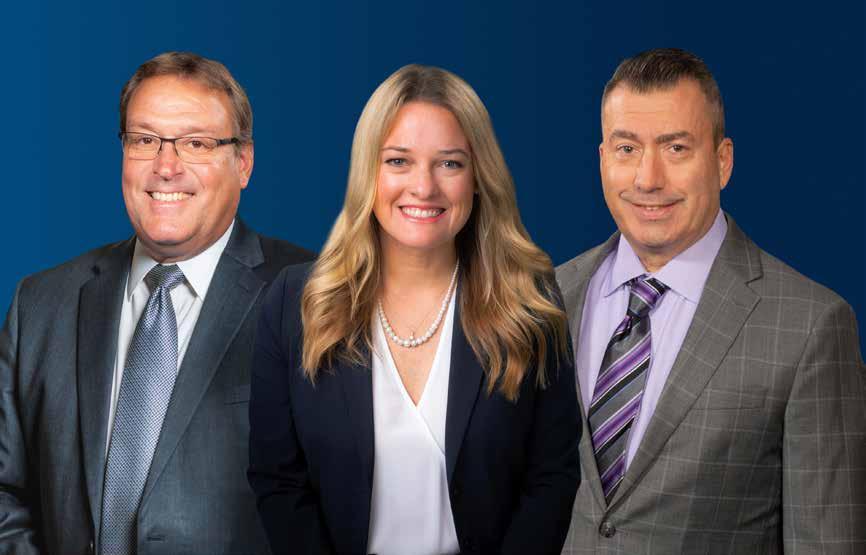
GREATER LAFAYETTE MAGAZINE 89
765.269.4790 | StateBank1910.bank 3690 Concord Road, Lafayette, IN 47909
Tony Albrecht Casey Spencer Brad Marley
Whether you are a lifelong resident, a newcomer, thinking of moving here or just visiting, the Visit Team can provide valuable insights to the community. Give us a call, email us, or stop in at the visitors center for assistance.
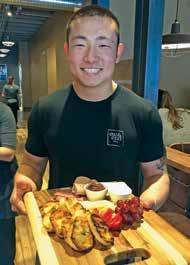

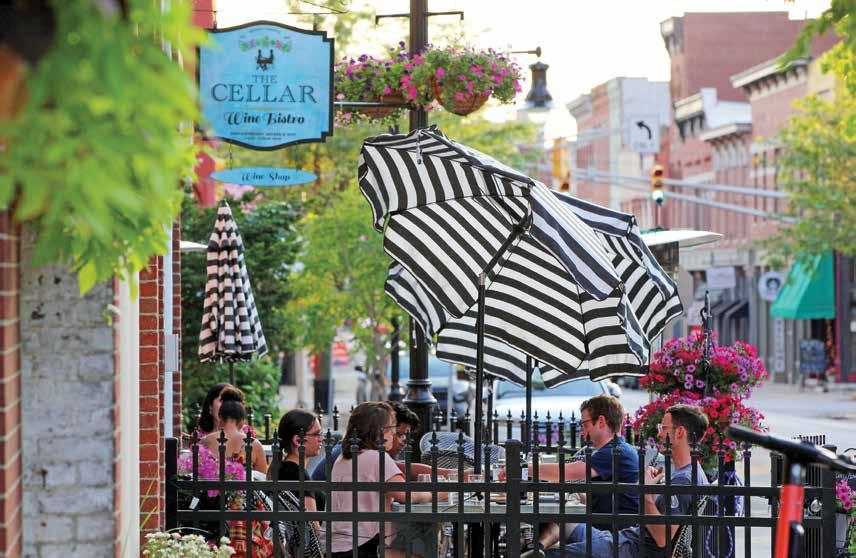

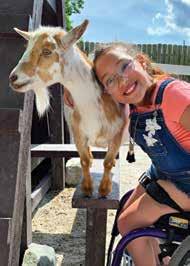
90 GREATER LAFAYETTE MAGAZINE 301 Frontage Road, Lafayette, IN 47905 • HomeOfPurdue.com • 800-872-6648 BELONG
VISIT
HomeOfPurdue.com offers lots of great info! PLAY WORK
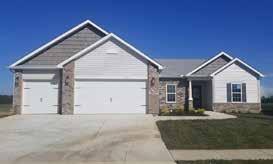

GREATER LAFAYETTE MAGAZINE 91 For an amazing new, custom-built home and an equally amazing home-buying experience, choose Timberstone — Greater Lafayette's local builder dedicated to offering the highest standard in design style, quality workmanship and service integrity in Indiana. Barrington Woods neighborhood now selling in Lafayette. • Homes starting from the 300’s • • Across from Wyandotte Elementary School • • Basement sites available • • Wooded lots still available • For more information call Chris Scheumann at 765.412.8827 or visit Timberstone-Homes.com Auburn Meadows neighborhood now selling in West Lafayette.
GET BACK TO FEELING AMAZING

Get In, Get Out, Get Better.
When minor illnesses or injuries suddenly arise, it can feel like an inconvenience. But it’s going to be okay –
The sooner you get in, get treatment and get answers, the sooner you can go from feeling yucky to feeling some relief.
Open 7 days a week for both in-person and virtual visits.
FranciscanExpressCare.org

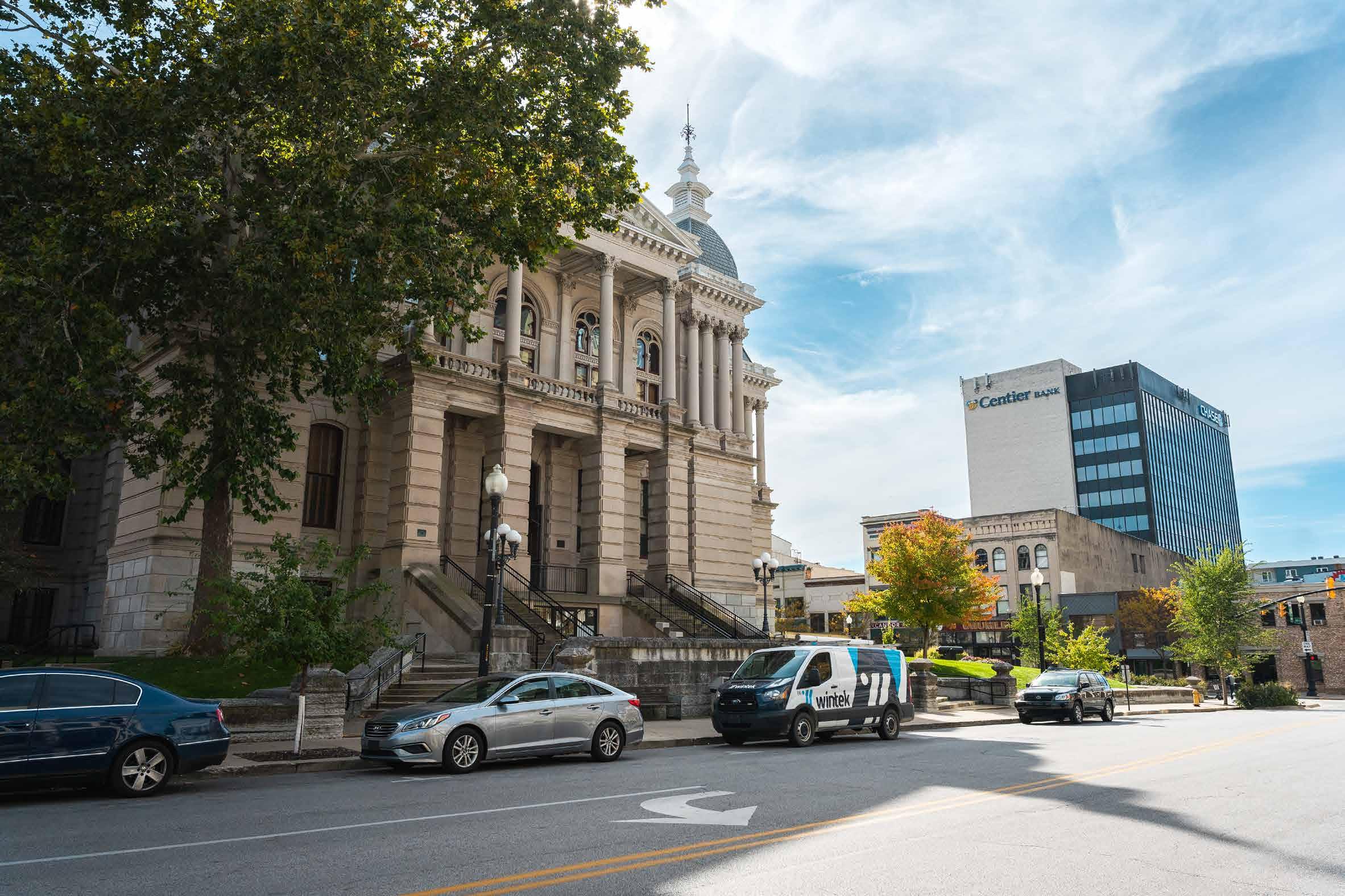



Celebrating five decades of impact and innovation in greater Lafayette. wintek.com

94 GREATER LAFAYETTE MAGAZINE LAFAYETTE 250 Main Street, Lafayette IN, 47901 765.423.7124 Deposit accounts and loan products are offered by First Merchants Bank, Member FDIC, Equal Housing Lender. First Merchants Private Wealth Advisors products are not FDIC insured, are not deposits of First Merchants Bank, are not guaranteed by any federal government agency, and may lose value. Investments are not guaranteed by First Merchants Bank and are not insured by any government agency. WE’LL HELP YOU SEE BEYOND THE BOTTOM LINE Running a business takes more than access to the right tools – it takes knowledge, perseverance, and, sometimes, a helping hand. First Merchants’ responsive bankers have years of expertise and adaptive financial advice to help your business grow – from concept to legacy. COMMERCIAL BANKING | PERSONAL BANKING | PRIVATE WEALTH

GREATER LAFAYETTE MAGAZINE 95 We’ve been buying and selling real estate in Greater Lafayette for over 100 years. Let us simplify the process for you. 765-742-1400 • www.shook.com • 300 N 5th Street, Downtown Lafayette Your Greater Lafayette real estate experts 136007 SHOOK SHOOK KAY INSURANCE Home, Auto, Farm, & Business SHOOK PROPERTY MANAGEMENT
96 GREATER LAFAYETTE MAGAZINE Federally insured by NCUA. PURDUEFED.COM




























 STORY AND PHOTOS BY TIM BROUK
STORY AND PHOTOS BY TIM BROUK






































 BY KAT BRATZ PHOTOS PROVIDED
BY KAT BRATZ PHOTOS PROVIDED















 BY JILLIAN ELLISON PHOTOS ON THIS PAGE
BY CHRISTINE PETKOV
BY JILLIAN ELLISON PHOTOS ON THIS PAGE
BY CHRISTINE PETKOV
















 BY KEN THOMPSON PHOTOS PROVIDED
BY KEN THOMPSON PHOTOS PROVIDED








































































